Emission Nebulae
M8 - Lagoon Nebula
(all images of M8)
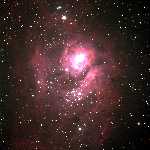 |
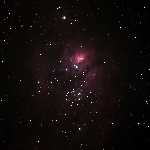 |
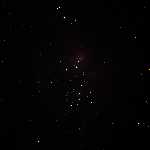 |
| Imax=5 | Imax=20 | Imax=100 |
SBIG ST-4K with 8″ f/6 Newtonian, 1200s total exposure 6/14/12 Monte Bello Open Space Preserve, CA
Our first image of an emission nebula with the ST-4K!
M16 - Eagle Nebula
(all images of M16)
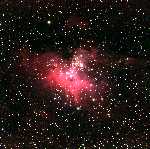 |
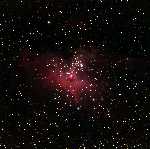 |
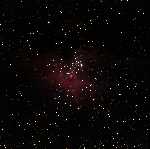 |
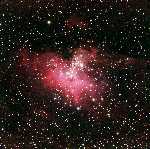 |
| Imax=2 | Imax=5 | Imax=10 | Nonlinear |
SBIG ST-4K with 8″ f/6 Newtonian, 2100s total exposure 7/7/13 Adin, CA
M16 contains both an open cluster and the Eagle nebula, including the "pillars of creation" that are well known from the famous Hubble picture. This was an attempt to obtain a larger image using the new camera. Visually, the faint glow of the nebula was easily seen under the dark skies at Adin, but I still could not detect the pillars visually. I hope we'll get to see this through a large telescope someday.
M17 - Swan Nebula
(all images of M17)
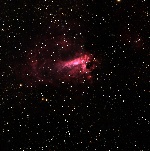 |
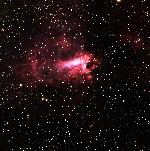 |
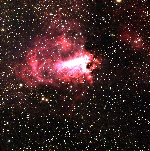 |
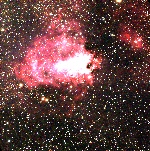 |
| Imax=10 | Imax=5 | Imax=2 | Imax=1 |
SBIG ST-4K with 8″ f/6 Newtonian, 900s total exposure 9/22/17 Whisper Canyon, CA
This is a new image of M17 taken with the ST-4K camera. Although the image is not quite as sharp as the previous image obtained with the Starshoot camera, it covers a much larger area and shows fainter features. The ST-4K camera also shows the hydrogen-alpha emission (red features) more brightly relative to dust (blue-white features).
M20 - Trifid Nebula
(all images of M20)
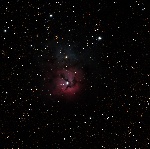 |
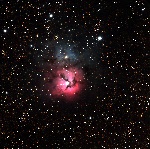 |
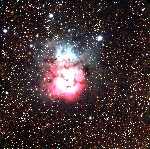 |
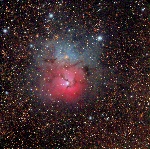 |
| Imax=10 | Imax=3.50 | Imax=1 | Nonlinear |
SBIG ST-4K with 8″ f/6 Newtonian, 1800s total exposure 9/26/14 Lake San Antonio, CA
We finally used the new camera to get a reasonably deep exposure of the Trifid nebula, which presents a beautiful combination of emission, reflection, and dark nebulae.
M42 - Orion Nebula
(all images of M42)
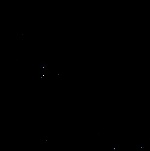 |
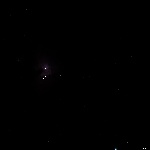 |
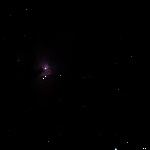 |
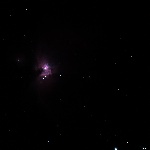 |
| Imax=16000 (1s) | Imax=2000 (5s) | Imax=1000 (5s) | Imax=500 (5s) |
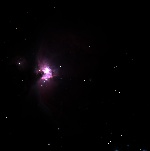 |
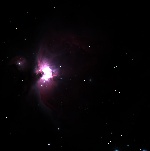 |
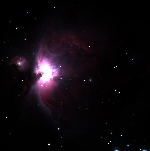 |
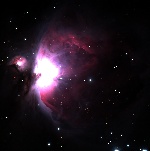 |
| Imax=200 | Imax=100 | Imax=50 | Imax=20 |
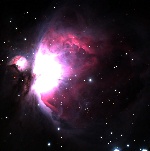 |
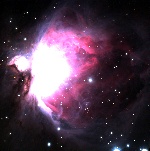 |
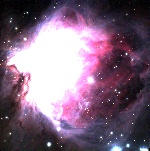 |
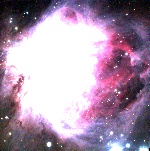 |
| Imax=10 | Imax=5 | Imax=2 | Imax=1 |
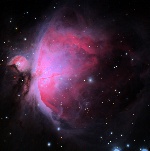 |
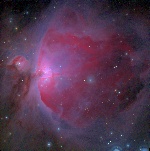 |
| Nonlinear | Nonlinear |
SBIG ST-4K with 8″ f/6 Newtonian, 1800s exposure at 300s, 9/22/17 Whisper Canyon, CA
This was my latest attempt to capture the full range of features visible in the Orion Nebula. The scaled images above were made by combining 21 images with 1s exposure, 15 images with 5s exposure, or 6 images with 300s exposure, the last exposure happening as the sky was just starting to brighten before dawn. The first image shows the main stars, including the trapezium. In the next few images, which show the bright core of the nebula, a bright red shelf appears, with a dark protrusion in front of it (just above a bright star). I am not able to see this feature visually, perhaps because our eyes are not very sensitive to hydrogen-alpha emission, and we see mainly the oxygen-III emission, which appears blue with this camera. I think the images out to Imax=20 show roughly the extent of the nebula that can be seen visually. The third row maintains linear scaling, showing the fainter features at the periphery of the nebula, while saturating the center. The bottom row shows two nonlinear scaling methods, applied after replacing the saturated pixels from the 300s exposures with values taken from the 5s exposures. The image on the left used a histogram equalization method, and the image on the right used a logarithmic scaling. Both methods maintain the hue at each location, applying the nonlinear scaling to the intensity only. These methods drastically change the appearance, but allow textural features to be followed over the entire field of view.
NGC 281
(all images of NGC 281)
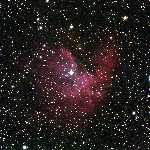 |
| Imax=1.2 |
SBIG ST-4K with 8″ f/6 Newtonian, 1800s total exposure 7/6/13 Adin, CA
This is our latest attempt at this diffuse emission and dark nebula near η Cassiopeiae. Though faint, the nebulosity can barely be made out visually.
NGC 1499 - California Nebula
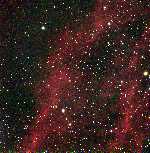 |
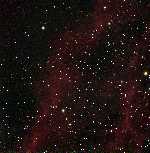 |
| Imax=0.5 | Imax=1 |
SBIG ST-4K with 8″ f/6 Newtonian, 1500s total exposure 9/14/12 Lake San Antonio, CA
This image shows just a small portion of a diffuse nebula in Perseus whose shape, as seen in wide-angle photographs, vaguely resembles the outline of California.
NGC 1893 / IC 410
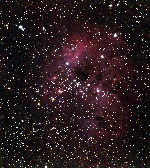 |
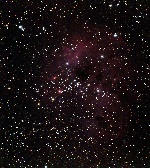 |
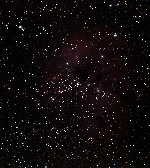 |
| Imax=1 | Imax=1.70 | Imax=3 |
SBIG ST-4K with 8″ f/6 Newtonian, 2400s total exposure 9/23/17 Whisper Canyon, CA
NGC 1893 is an open star cluster in Auriga, and the surrounding emission nebula is IC 410. The image shows a large, diffuse emission nebula with apparent dark nebulae in front, and a pair of “streamers” pointing generally away from the center of the star cluster.
NGC 2023 / IC 434 / B33 (Horsehead Nebula)
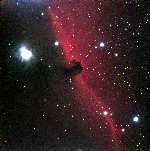 |
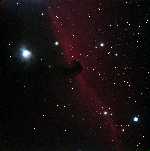 |
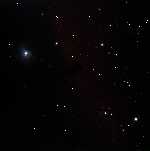 |
| Imax=0.8 | Imax=2 | Imax=8 |
SBIG ST-4K with 8″ f/6 Newtonian, 1177s total exposure 9/14/12 Lake San Antonio, CA
I have been wanting for years to capture the Horsehead, but because Orion rises late at Calstar, this famous object has so far eluded us. This time, even though we were having battery problems, we saved our spare battery for the Horsehead, and were able to get about 20 minutes of exposure on it. The bright reflection nebula at left is NGC 2023, the Horsehead is B33, and the emission nebula associated with it is IC 434. Visually, I might have been able to detect something dark are the right location using averted vision, without using filters. I also tried an H-Beta filter I picked up at a recent swap meet, but the results were disappointing - I could not really see anything with it.
NGC 2024 - Flame Nebula
(all images of NGC 2024)
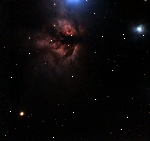 |
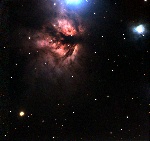 |
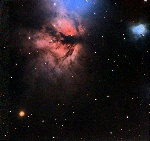 |
| Imax=3.50 | Imax=1.50 | Nonlinear |
SBIG ST-4K with 8″ f/6 Newtonian, 1800s total exposure 10/3/13 Lake San Antonio, CA
This is an emission / dark nebula near the belt star ζ Orionis (just outside the field of view near the top), which is thought to be the excitation source. The dark features look similar to those of the Trifid nebula, but with more detail. The reflection nebula in the upper right is NGC 2023.
NGC 2070 - Tarantula Nebula
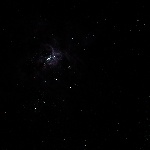 |
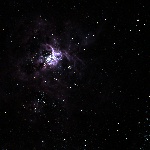 |
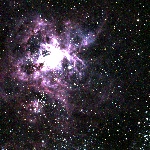 |
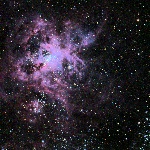 |
| Imax=35 | Imax=7 | Imax=1 | Nonlinear |
SBIG ST-4K with 10″ LX200 telescope, 600s total exposure 2/17/23 Whangaparaoa, NZ
The Tarantula Nebula, located in the Large Magellanic Cloud, is visually spectacular despite its distance of 160,000 light years, 120 times farther than the Orion Nebula. It includes a central star cluster, a number of chambers, some dark features, and numerous tentacles extending outwards, nearly connecting with neighboring, smaller nebulae (see additional photos below). Its size of approximately 1900 ly is comparable to the more distant NGC 604 in the Triangulum Galaxy.
Large Magellanic Cloud Nebulae
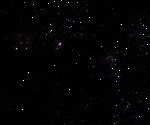 |
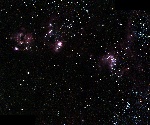 |
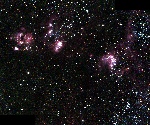 |
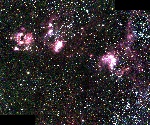 |
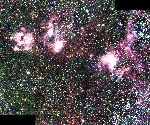 |
 |
| Imax=10 | Imax=2 | Imax=1 | Imax=0.50 | Imax=0.25 | Nonlinear |
SBIG ST-4K with 10″ LX200 telescope, 1200s total exposure 2/20/23 Whangaparaoa, NZ
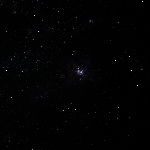 |
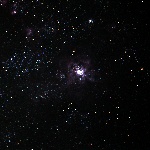 |
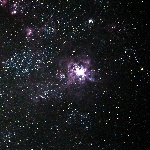 |
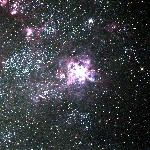 |
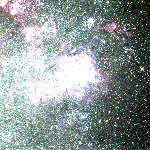 |
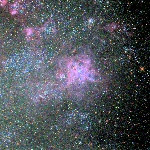 |
| Imax=90 | Imax=20 | Imax=7 | Imax=3 | Imax=1 | Nonlinear |
SBIG ST-4K with 8″ f/4 Newtonian, 300s total exposure 2/21/23 Whangaparaoa, NZ
The image in the top row captures a few of the other emission nebulae in the Large Magellanic Cloud close to the Tarantula Nebula. Some of the objects include NGC 2083 (farthest left and above center), NGC 2080 (slightly upper-left of center), NGC 2085-6 (between and above 2080 and 2083), and NGC 2081 (right of center). The scaled-up versions also show hints of dark nebulae (ignoring the tiling artifacts caused by the lack of a flat-field correction). The image in the bottom row used the 8″ f/4 Newtonian to capture a larger field of view surrounding the Tarantula Nebula. Emission nebulae include NGC 2070 (center), NGC 2081 (towards upper-left), and NGC 2080, 2085-6 and 2083 (extreme upper-left). Star clusters include NGC 2100 (top, slightly right of center), NGC 2094 (right, slightly above center), and NGC 2042 (below center). Both of these images capture only a small portion of the Large Magellanic cloud.
NGC 2237 - Rosette Nebula
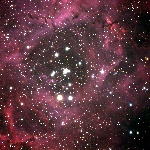 |
| Imax=1 |
SBIG ST-4K with 8″ f/6 Newtonian, 1800s total exposure 9/25/19 Lake San Antonio, CA
The Rosette Nebula in Monoceros includes an open cluster (NGC 2244) and regions of surrounding nebula (NGC 2237-2239, 2246). This object is somewhat difficult to image at Calstar because it rises late. On the night of Sept. 25-26, it seemed high enough to start imaging at around 4:30am. Not long after I started, a thin crescent moon rose in the east, but the sky seemed dark enough to continue for a while. The dark clouds in the upper part of the image are quite interesting, including some rather small objects (globules? Bok globules?). The estimated distance to the Rosette Nebula is 5200 light years (compared with 1340 ly for the Orion Nebula).
NGC 2264 and Cone Nebula
(all images of NGC 2264)
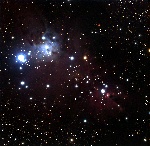 |
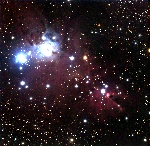 |
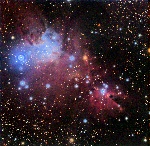 |
| Imax=1 | Imax=0.50 | Nonlinear |
SBIG ST-4K with 8″ f/6 Newtonian, 5400s total exposure 10/4/13 Lake San Antonio, CA
NGC 2264, in the constellation Monoceros, includes an open star cluser known as the Christmas Tree cluster (left and center), a bright reflection nebula (upper-left), a large area of faint emission, and the spectacular Cone Nebula at lower-right. The reflection nebula can be seen visually, but the emission nebula and Cone features are too faint. The distance is approximately 2700 light years.
NGC 3199
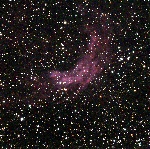 |
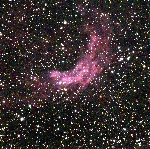 |
| Imax=0.50 | Imax=0.30 |
SBIG ST-4K with 10″ LX200 telescope, 1800s total exposure 2/19/23 Whangaparaoa, NZ
NGC 3199 is a crescent-shaped nebula located near a Wolf-Rayet star in Carina. We could see it visually, but it was faint. This exposure may have also been affected by condensation on the optics.
NGC 3372 - Carina Nebula
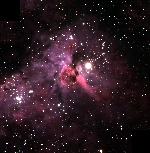 |
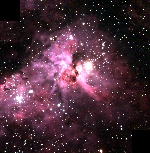 |
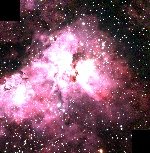 |
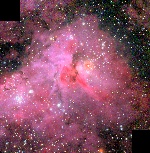 |
| Imax=3.50 | Imax=2 | Imax=1 | Nonlinear |
SBIG ST-4K with 10″ LX200 telescope, 1200s total exposure 2/16/23 Whangaparaoa, NZ
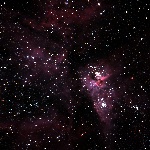 |
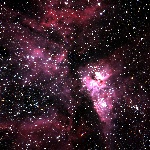 |
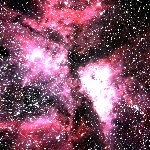 |
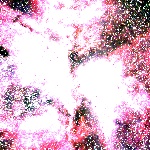 |
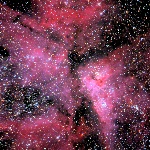 |
| Imax=30 | Imax=12 | Imax=4 | Imax=1 | Nonlinear |
SBIG ST-4K with 8″ f/4 Newtonian, 300s total exposure 2/21/23 Whangaparaoa, NZ
The Carina Nebula is a vast emission nebula rivaling the Orion and Lagoon Nebulae in the amount of visual detail that can be seen, though the Carina Nebula is actually more distant and larger. At a declination of -60°, it can only be seen well from southern latitudes. The image in the top row captures only the portion around η Carinae (the brightest star in the image, slightly above and to the right of center). The field of view includes a heart-like object near the center along with a number of dark pillars and globules spread across the image.
The second row shows another image of the Carina Nebula taken using the 8″ f/4 Newtonian scope to capture a wider field of view. At the lower magnification we can see the structure of the dark lanes that divide the nebula into several regions.
NGC 6559
(all images of NGC 6559)
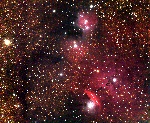 |
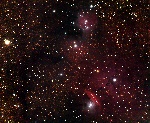 |
| Imax=1 | Imax=2 |
SBIG ST-4K with 8″ f/6 Newtonian, 4500s total exposure 7/22/17 Monte Bello, CA
Here is another attempt at this interesting emission nebula in Sagittarius. This version has improved sharpness, since there were no wind problems, but the background is somewhat uneven due to the relatively bright sky at Monte Bello.
NGC 6888 - Crescent Nebula
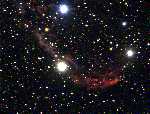 |
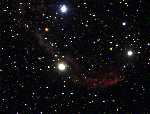 |
| Imax=10 | Imax=20 |
Starshoot DSCI with 8″ f/6 Newtonian, 80 exposures, 20s each 7/12/10 Adin, CA
This image captures only the brightest portion of a large kidney-shaped object. The bright star near the top of this image is thought to be the source of the luminous gas.
NGC 7000 - North American Nebula
(all images of NGC 7000)
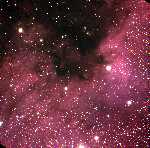 |
| Imax=0.7 |
SBIG ST-4K with 8″ f/6 Newtonian, 3900s total exposure 9/13/12 Lake San Antonio, CA
This was our first photograph at Calstar taken with the new camera. It was almost straight overhead, in ideal position, and we gave it more than an hour of exposure. Usually the North American Nebula is imaged with a wide field setup to show its full extent and its position alongside the Pelican Nebula. However there are many fine details that can be seen with higher magnification, such as the small reflection nebula near the top of this image. Visually, this is a challenging object, but a faint glow can be made out.
NGC 7000 - North American Nebula
(all images of NGC 7000)
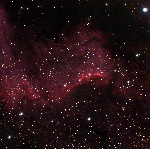 |
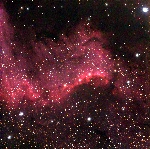 |
| Imax=1.40 | Imax=0.70 |
SBIG ST-4K with 8″ f/6 Newtonian, 4200s total exposure 9/25/14 Lake San Antonio, CA
This image shows the 'Mexico' region of the North American nebula, which includes some of the brightest and most interesting structures.
NGC 7635 - Bubble Nebula
(all images of NGC 7635)
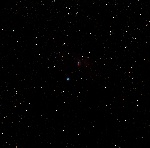 |
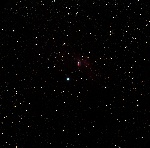 |
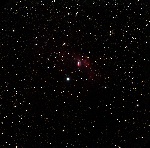 |
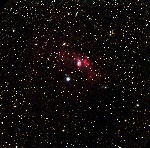 |
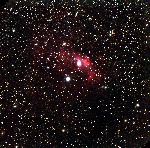 |
| Imax=20 | Imax=10 | Imax=5 | Imax=2 | Imax=1 |
SBIG ST-4K with 8″ f/6 Newtonian, 2700s total exposure 9/21/17 Whisper Canyon, CA
Emission nebula in Cassiopeia. The 'bubble' is thought to be created by stellar wind from a central star colliding with surrounding gas. Note also the red object near the central star. While it appears quite bright in photographs, I was not able to detect it visually.
IC 1318
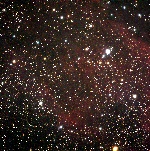 |
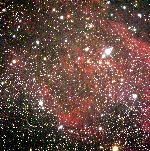 |
| Imax=1 | Imax=0.50 |
SBIG ST-4K with 8″ f/6 Newtonian, 900s total exposure 9/10/15 Whisper Canyon, CA
A portion of IC 1318 (near Gamma Cygni).
IC 1805 - Heart Nebula
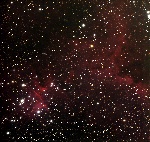 |
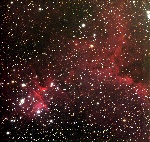 |
| Imax=1 | Imax=0.60 |
SBIG ST-4K with 8″ f/6 Newtonian, 4500s total exposure 9/25/14 Lake San Antonio, CA
The field of view here is too small to see the 'heart' shape. Our interest was to capture the three dark pillar structures appearing in the right portion of this image, with their unusual webbed and twisted appearance.
IC 4701
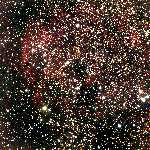 |
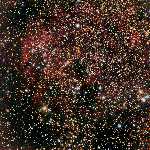 |
| Imax=0.5 | Nonlinear |
SBIG ST-4K with 8″ f/6 Newtonian, 2083s total exposure 7/9/13 Adin, CA
This is an obscure target, chosen somewhat randomly from the star chart. This patch of faint nebuosity (and a lot of stars) is located near the Swan nebula.
IC 5146 - Cocoon Nebula
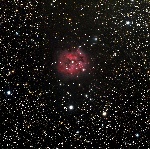 |
| Imax=1 |
SBIG ST-4K with 8″ f/6 Newtonian, 2700s total exposure 9/26/14 Lake San Antonio, CA
With its round shape and combination of emission, reflection, and dark nebulae, the Cocoon Nebula in Cygnus has some similarity to the brighter Trifid nebula. Note that in addition to the dark patches in front of the emission nebula, there is a much larger surrounding dark region (part of dark nebula B168) where the background stars are obscured.
Reflection Nebulae
M45 - Pleiades
(all images of the Pleiades)
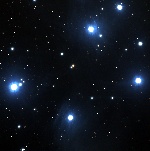 |
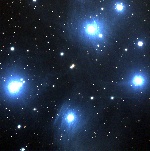 |
| Imax=5 | Imax=2 |
SBIG ST-4K with 8″ f/6 Newtonian, 1800s total exposure 9/25/14 Lake San Antonio, CA
This image includes 5 of the 6 brightest stars in the well-known Pleiades cluster: Alcyone (left), Merope (bottom), Electra (right), Maia (near top), and Taygeta (extreme upper-right). Visually, some of the reflection nebula can be seen as a faint haze, but it is difficult to distinguish it from the scattering one might expect from dirt or condensation on the optics. Here, the reflection nebula has the appearance of cirrus clouds, with a fine texture and long streaks traveling in several directions.
M20 - Trifid Nebula
(all images of M20)
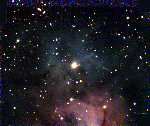 |
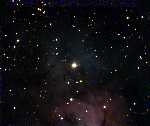 |
| Imax=15 | Imax=30 |
Starshoot DSCI with 8″ f/6 Newtonian, 175 exposures, 10s each 9/18/09 Lake San Antonio, CA
This is again the Trifid nebula, but now centered on the reflective portion. The emissive portion can be seen at the bottom, and partly overlaps with the image from last year.
M78
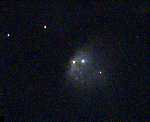 |
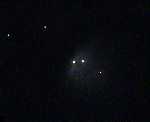 |
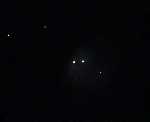 |
| Imax=20 | Imax=40 | Imax=80 |
Starshoot DSCI with 8″ f/6 Newtonian, 10 exposures, 20s each 9/29/11 Lake San Antonio, CA
Reflection nebula in Orion. It looks like a little ghost!
NGC 1333
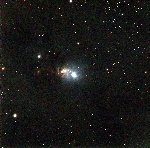 |
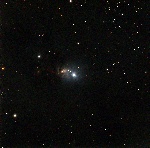 |
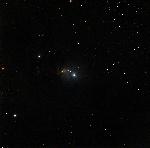 |
| Imax=0.50 | Imax=1 | Imax=2 |
SBIG ST-4K with 8″ f/6 Newtonian, 2100s total exposure 9/28/19 Lake San Antonio, CA
NGC 1333 in Perseus is mainly a reflection nebula, but it contains some other striking features that resemble eggs with red dots inside, apparently related to new star formation. These features barely came out in 35 minutes of exposure, but this nebula is so unusual that I may need to try capturing it again when I have a more automated system.
NGC 1788
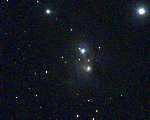 |
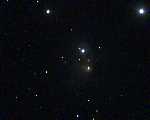 |
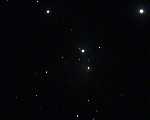 |
| Imax=10 | Imax=20 | Imax=40 |
Starshoot DSCI with 8″ f/6 Newtonian, 53 exposures, 20s each 10/1/11 Lake San Antonio, CA
Here you can see only the brightest portion of this complex of reflection, emission and dark nebulae in Orion.
NGC 1973
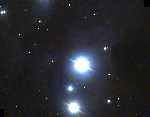 |
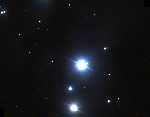 |
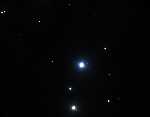 |
| Imax=40 | Imax=80 | Imax=400 |
Starshoot DSCI with 8″ f/6 Newtonian, 27 exposures, 20s each 9/29/11 Lake San Antonio, CA
Bright reflection nebula near the Orion nebula. It is fairly bright, but the bright stars contained within make it more difficult to see visually.
NGC 2261
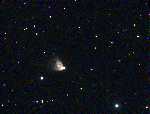 |
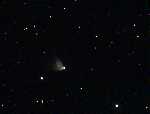 |
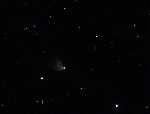 |
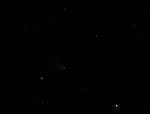 |
| Imax=20 | Imax=50 | Imax=100 | Imax=500 |
Starshoot DSCI with 8″ f/6 Newtonian, 29 exposures, 15s each 9/30/11 Lake San Antonio, CA
This comet-like nebula is known as Hubble's Variable Nebula because its appearance changes over timescales as short as a few days. The nebula is illuminated by the bright star at its tip. The brightness fluctuations are thought to result from shadows cast by moving dust clouds swirling around the star.
NGC 7023 - Iris Nebula
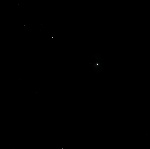 |
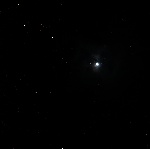 |
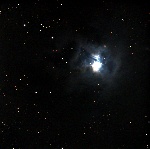 |
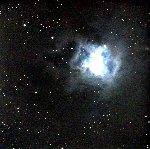 |
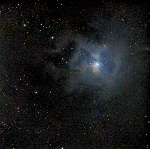 |
| Imax=200 | Imax=20 | Imax=2 | Imax=0.50 | Nonlinear |
SBIG ST-4K with 8″ f/6 Newtonian, 1800s total exposure 9/24/22 Lake San Antonio, CA
This is a reflection nebula in Cepheus with a lot of interesting structure including dark regions and an opening. Initially I did not realize how large and diffuse it would be, or perhaps I would have planned for a longer exposure. I also did not take any useful flat-field data, so I resorted to using the sky glow from some test images taken in Palo Alto, where the camera alignment was probably different.
NGC 7129
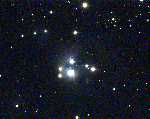 |
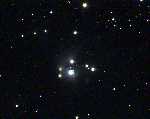 |
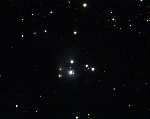 |
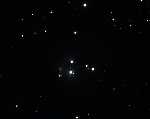 |
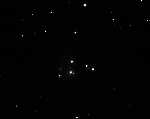 |
| Imax=7.5 | Imax=15 | Imax=30 | Imax=60 | Imax=120 |
Starshoot DSCI with 8″ f/6 Newtonian, 61 exposures, 20s each 7/13/10 Adin, CA
This is an interesting reflection/emission nebula in Cepheus. Only the brightest parts can be seen clearly here.
AE Aurigae / IC 405
(all images of IC 405)
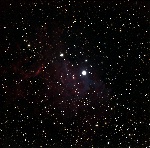 |
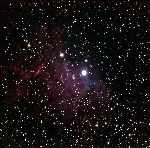 |
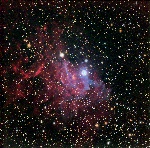 |
| Imax=2 | Imax=1 | Nonlinear |
SBIG ST-4K with 8″ f/6 Newtonian, 3600s total exposure 10/5/13 Lake San Antonio, CA
IC 405, also known as the Flaming Star nebula, contains clouds of dust (blue) and gas (red) that are believed to have been present before the brightest star in the image, AE Aurigae, traveled near it, providing illumination. This is our first decent image of this rather faint object after a couple of tries.
IC 348
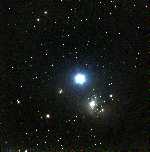 |
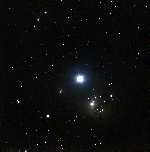 |
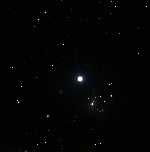 |
| Imax=1 | Imax=2 | Imax=7 |
SBIG ST-4K with 8″ f/6 Newtonian, 1500s total exposure 9/14/12 Lake San Antonio, CA
This is a nice little reflection nebula near ο Persei.
IC 4955
(all images of IC 4955)
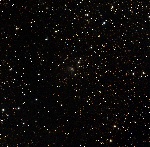 |
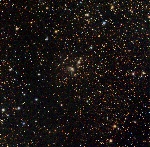 |
| Imax=2 | Nonlinear |
SBIG ST-4K with 8″ f/6 Newtonian, 2700s total exposure 9/27/14 Lake San Antonio, CA
This reflection nebula in Vulpecula consists of several faint wisps around a loose star cluster. A well-defined edge is visible on one of them.
Dark Nebulae
B86 and NGC 6520
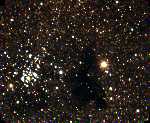 |
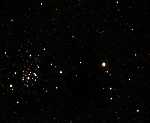 |
| Imax=20 | Imax=200 |
Starshoot DSCI with 8″ f/6 Newtonian, 204 exposures, 10s each 9/17/09 Lake San Antonio, CA
The black patch at center is Barnard 86, a dark nebula in the Sagittarius Star Cloud near the center of the Milky Way. The star cluster to its left is NGC 6520.
B72 - Snake Nebula
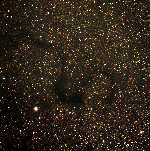 |
| Imax=1.5 |
SBIG ST-4K with 8″ f/6 Newtonian, 1800s total exposure 9/14/12 Lake San Antonio, CA
This is another dark nebula that can be seen against the dense stars of the Milky Way in the southern part of Ophiuchus. It was rather low in the sky.
B92
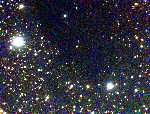 |
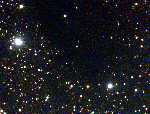 |
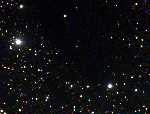 |
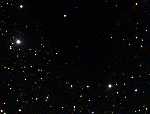 |
| Imax=5 | Imax=10 | Imax=20 | Imax=50 |
Starshoot DSCI with 8″ f/6 Newtonian, 157 exposures, 10s each 7/4/10 San Jose, CA
This dark nebula borders the 'small Sagittarius star cloud'. This image was taken a few miles south of San Jose. The sky conditions were such that the Milky Way in Sagittarius could be seen, but there was substantial sky glow. Under these conditions B92 was difficult to find, and it took many comparisons between acquired images and reference photographs to be sure of it. There was also substantial wind, so many images had to be discarded. Pluto is also in this image.
B142/143 - "E" Nebula
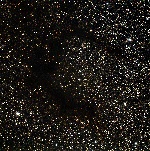 |
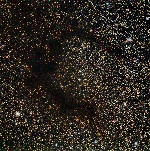 |
| Imax=1 | Nonlinear |
SBIG ST-4K with 8″ f/6 Newtonian, 2100s total exposure 10/4/13 Lake San Antonio, CA
This image shows the darkest portion of a dark nebula in Aquila known as the "E" nebula (the name is a little puzzling since, even in wide field images, the dark shape doesn't look much like an E). A reddening of stars near the edges of the dark patches is clearly seen. It is easier to see this in the "nonlinear" image, since the processing method used there retains the star colors even when the intensity saturates the display.
Planetary Nebulae
M27 - Dumbbell Nebula
(all images of M27)
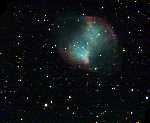 |
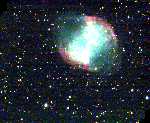 |
| Imax=30 | Imax=10 |
Starshoot DSCI with 8″ f/6 Newtonian, 18 exposures, 30s each 9/25/08 Lake San Antonio, CA
Visually, we could see only a little bit of structure, and no color.
M57 - Ring Nebula
(all images of M57)
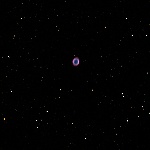 |
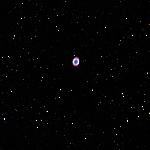 |
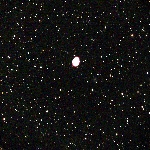 |
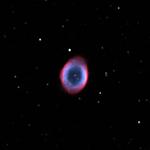 |
| Imax=30 | Imax=15 | Imax=2 | Deconvolved |
SBIG ST-4K with 8″ f/6 Newtonian, 540s total exposure 9/23/22 Lake San Antonio, CA
One more sequence of 60s exposures I took because the seeing looked better than the previous night. Since the signal-noise ratio was pretty good for this image, I was able to get some useful sharpness increase using a deconvolution filter (right).
M76 - Little Dumbbell
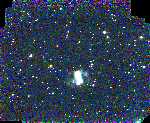 |
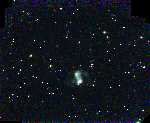 |
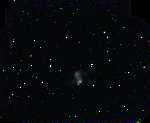 |
| Imax=5 | Imax=15 | Imax=40 |
Starshoot DSCI with 8″ f/6 Newtonian, 131 exposures, 10s each 9/19/09 Lake San Antonio, CA
A planetary nebula in Perseus. Although it is small, the central bar structure could be seen visually fairly easily.
M97 - Owl Nebula
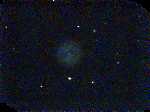 |
| Imax=20 |
Starshoot DSCI with 8″ f/6 Newtonian, 46 exposures, 10s each 12/29/08 Phoenix, AZ
This object is faint, but it appears to have a green color. I ended up with a small number of exposures here due to wind problems.
NGC 40
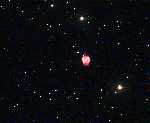 |
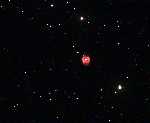 |
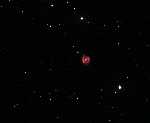 |
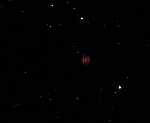 |
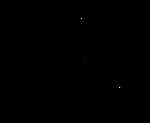 |
| Imax=20 | Imax=40 | Imax=80 | Imax=160 | Imax=2000 |
Starshoot DSCI with 8″ f/6 Newtonian, 148 exposures, 10s each 10/8/10 Lake San Antonio, CA
We picked this target because the RASC Observer's Handbook described it as an 'unusual red planetary,' and it didn't disappoint! Like many planetaries, the central star appears blue.
NGC 246
(all images of NGC 246)
 |
 |
 |
| Imax=1 | Imax=240 | Nonlinear |
SBIG ST-4K with C14 at f/7, 1500s total exposure 10/04/24 Lake San Antonio, CA
Known as the "Skull Nebula", NGC 246 is a diffuse planetary nebula in Cetus. The color of the blue central star can be seen in the second image, which is scaled to avoid saturating the color. Although the resolution is not great in this image, the nonlinearly scaled image on the right also shows a white-colored star just next to the blue central star. Clouds were present during this exposure sequence, and at least one of the frames used in the image stacking had reduced transmission and increased background.
NGC 1501
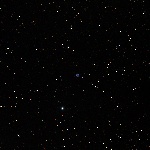 |
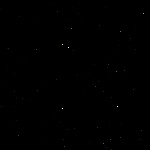 |
| Imax=6 | Imax=100 |
SBIG ST-4K with 8″ f/6 Newtonian, 1200s total exposure 9/27/14 Lake San Antonio, CA
This happy blue planetary nebula in Camelopardalis surprised us with its interesting color and texture.
NGC1514
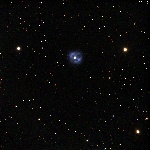 |
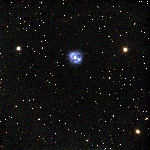 |
| Imax=1.50 | Imax=0.75 |
SBIG ST-4K with C14 + f/7 reducer, 1200s total exposure 9/22/22 Lake San Antonio, CA
A planetary nebula in Taurus with a blue color and many dark bubbles.
NGC 2392 - Eskimo Nebula
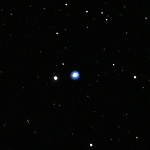 |
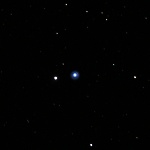 |
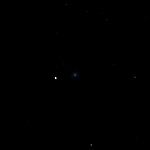 |
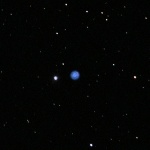 |
| Imax=25 | Imax=65 | Imax=500 | Nonlinear |
SBIG ST-4K with 8″ f/6 Newtonian, 300s total exposure 10/3/13 Lake San Antonio, CA
In certain photographs, this planetary nebula in Gemini resembles a face surrounded by a thick hood. For the best chance of seeing that here, tilt your head 90 degrees to the right and look at the nonlinearly scaled image. The blue and purple color combination seems unusual.
NGC 5189 - Spiral Planetary Nebula
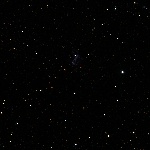 |
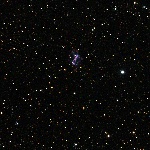 |
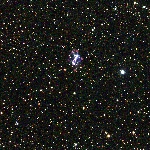 |
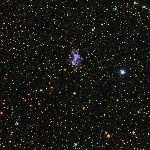 |
| Imax=12 | Imax=3 | Imax=1 | Nonlinear |
SBIG ST-4K with 10″ LX200 telescope, 300s total exposure 2/20/23 Whangaparaoa, NZ
This single guided exposure shows the complicated structure of this planetary nebula in Musca. The highest intensity range (lowest scaled) version on the left shows that the central star has a blue color, as is seen with many planetary nebulae. Visually, it was not difficult to detect the presence of the nebula, but I was not able to discern a spiral structure.
NGC 6302 - Bug Nebula
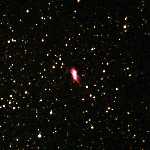 |
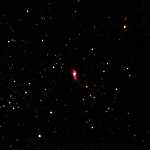 |
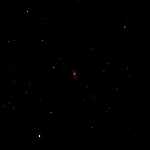 |
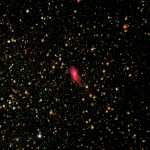 |
| Imax=3 | Imax=15 | Imax=80 | Nonlinear |
SBIG ST-4K with 8″ f/6 Newtonian, 1200s total exposure 7/7/13 Adin, CA
This planetary nebula in Scorpio is quite far south (declination -37°), and at Adin (41° N latitude) it only rises 12° above the horizon. Neverthess, this object was worth a look because of its unique shape.
NGC 6369 - "Little Ghost"
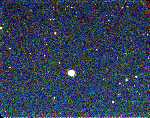 |
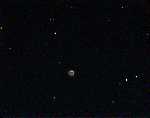 |
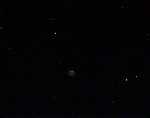 |
| Imax=5 | Imax=40 | Imax=100 |
Starshoot DSCI with 8″ f/6 Newtonian, 72 exposures, 10s each 9/18/09 Lake San Antonio, CA
A small planetary nebula in Ophiuchus. I had never looked at this one before, and Kathy chose it from the Observer's Handbook. Small but distinct, not difficult to see visually. Some faint outer structure is visible in the leftmost image.
NGC 6445
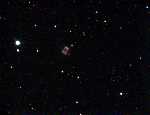 |
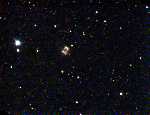 |
| Imax=40 | Imax=20 |
Starshoot DSCI with 8″ f/6 Newtonian, 12 exposures, 30s each 9/26/08 Lake San Antonio, CA
Kathy chose this planetary nebula in Sagittarius as a target, to make sure we looked at more than just the well-known showpiece objects. Visually we could tell that it was ring-like, and it shows some interesting color.
NGC6543 - Cat's Eye Nebula
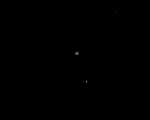 |
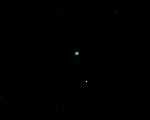 |
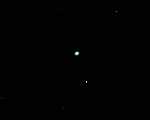 |
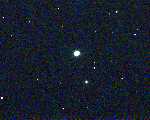 |
| Imax=1300 | Imax=800 | Imax=400 | Imax=20 |
Starshoot DSCI with 8″ f/6 Newtonian, 61 exposures, 5s each 7/11/10 Adin, CA
This turned out to be very bright but small, with not much structure visible at this resolution.
NGC 6781
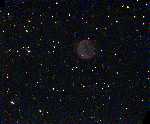 |
| Imax=15 |
Starshoot DSCI with 8″ f/6 Newtonian, 39 exposures, 20s each 10/1/11 Lake San Antonio, CA
This is a planetary nebula in Aquila. Visually it appeared as a faint glowing disk. As with many planetary nebulae, a blue star appears in the center.
NGC 6772
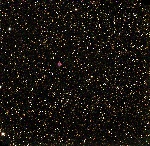 |
| Imax=1.35 |
SBIG ST-4K with 8″ f/6 Newtonian, 1200s total exposure 9/26/19 Lake San Antonio, CA
This is a planetary nebula in Aquila with a relatively low surface brightness but an interesting color contrast. A bluish central star seems to be visible.
NGC 6804
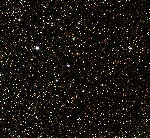 |
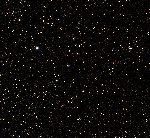 |
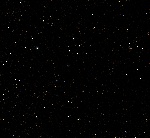 |
| Imax=2 | Imax=5 | Imax=25 |
SBIG ST-4K with 8″ f/6 Newtonian, 1200s total exposure 9/28/19 Lake San Antonio, CA
NGC 6804 is a planetary nebula in Aquila, not far from Altair. It shows a faint outer shell, a brighter inner shell, and a blue central star.
NGC 6818
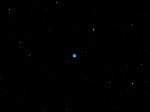 |
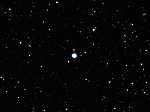 |
| Imax=70 | Imax=5 |
SBIG ST-4K with 8″ f/6 Newtonian, 600s total exposure 9/10/15 Whisper Canyon, CA
"Little Gem Nebula" in Sagittarius.
NGC 6826 - Blinking Planetary Nebula
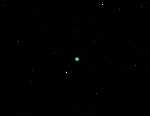 |
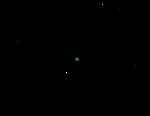 |
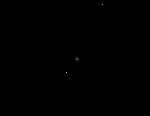 |
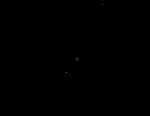 |
| Imax=500 | Imax=1000 | Imax=1500 | Imax=2600 |
Starshoot DSCI with 8″ f/6 Newtonian, 50 exposures, 10s each 10/9/10 Lake San Antonio, CA
Visually, when looking directly at this object you will mainly see the bright central star, but if you look off-center through the eyepiece, the surrounding nebula appears brighter.
NGC 6881
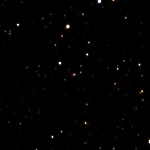 |
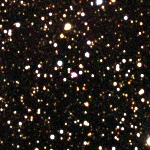 |
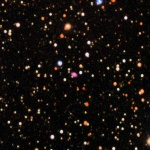 |
| Imax=30 | Imax=1 | Nonlinear |
SBIG ST-4K with C14 + f/7 reducer, 600s total exposure 9/23/22 Lake San Antonio, CA
This tiny planetary nebula in Cygnus resembles a pink football in this photo. With nonlinear scaling, the color appears uniform from the center to the edge.
NGC 6905 - Blue Flash Nebula
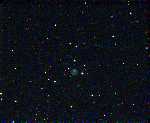 |
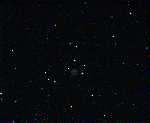 |
| Imax=150 | Imax=300 |
Starshoot DSCI with 8″ f/6 Newtonian, 1200s total exposure 9/15/12 Lake San Antonio, CA
This is a fairly bright planetary nebula in Delphinus that Kathy picked. It was not difficult to find visually. We went back to the old unguided imaging method, using only 5 second exposures for the best resolution. However, the exposures may have been a bit too short in this case.
NGC 7008
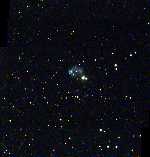 |
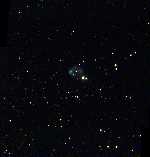 |
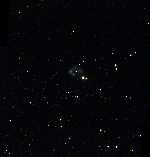 |
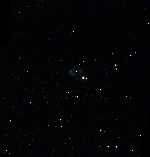 |
| Imax=20 | Imax=35 | Imax=50 | Imax=80 |
Starshoot DSCI with 8″ f/6 Newtonian, 28 exposures, 20s each 7/13/10 Adin, CA
Another planetary with some interesting structure, one of Kathy's picks.
NGC 7009 - Saturn Nebula
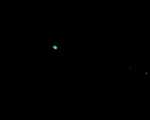 |
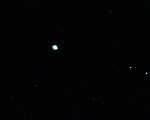 |
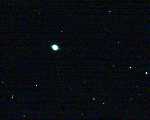 |
| Imax=1100 | Imax=200 | Imax=50 |
Starshoot DSCI with 8″ f/6 Newtonian, 20 exposures, 10s each 9/27/08 Lake San Antonio, CA
This planetary nebula has some interesting inner structure (can be seen only in the Imax=1100 image with full intensity scale) in addition to the faint rays ("ansae") for which this object is named.
NGC 7026
 |
 |
 |
 |
| Imax=100 | Imax=15 | Imax=2 | Nonlinear |
SBIG ST-4K with C14 at f/7, 300s total exposure 10/04/24 Lake San Antonio, CA
This planetary nebula in Cygnus presents a small but complicated structure with a bright, inner two-lobed structure surrounded by red and blue swirls.
NGC 7027
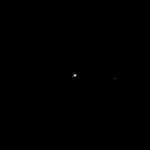 |
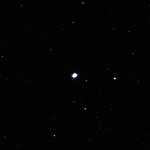 |
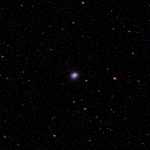 |
| Imax=1000 | Imax=100 | Nonlinear |
SBIG ST-4K with 8″ f/6 Newtonian, 190s total exposure 7/6/13 Adin, CA
This is a tiny but bright planetary nebula in Cygnus.
NGC 7048
 |
 |
| Imax=2.50 | Imax=1.50 |
SBIG ST-4K with C14 at f/7, 1800s total exposure 10/04/24 Lake San Antonio, CA
This planetary nebula in Cygnus shows a similiar appearance to many others, with a red (probably H-alpha) outer shell surrounding a blue (OIII) interior.
NGC 7139
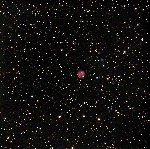 |
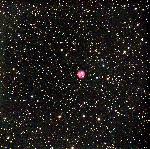 |
| Imax=1 | Imax=0.50 |
SBIG ST-4K with C14 + f/7 reducer, 1500s total exposure 9/24/22 Lake San Antonio, CA
This dim planetary nebula in Cepheus combines an outer, reddish broken ring with a bluish interior.
NGC 7293 - Helix Nebula
(all images of NGC 7293)
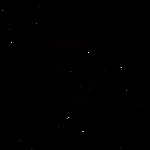 |
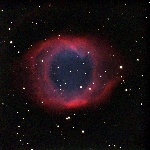 |
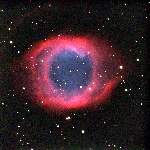 |
| Imax=40 | Imax=1 | Imax=0.50 |
SBIG ST-4K with C14 + f/7 reducer, 1800s total exposure 9/23/22 Lake San Antonio, CA
The Helix Nebula is a very large but diffuse planetary nebula in Aquarius. Here I was trying to improve on my previous attempt that suffered from both a low altitude and wind problems. For this attempt, the altitude was again very low, but at least there was no wind. There appears to be a slowly moving object at about the 10 o'clock position.
NGC 7662 - Blue Snowball
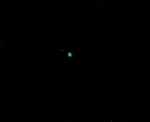 |
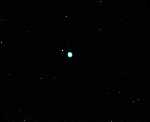 |
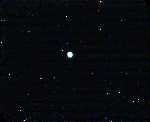 |
| Imax=860 | Imax=200 | Imax=50 |
Starshoot DSCI with 8″ f/6 Newtonian, 39 exposures, 10s each 9/27/08 Lake San Antonio, CA
Visually, we did not see any structure, just a blue blob. However, an interesting feature can be seen in the full-scale (Imax=860) image.
IC 289
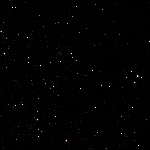 |
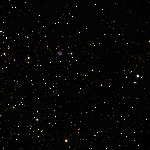 |
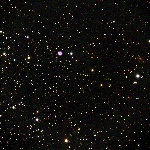 |
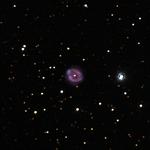 |
| Imax=12 | Imax=3 | Imax=1 | Deconvolved |
SBIG ST-4K with C14 + f/7 reducter, 1200s total exposure 9/22/22 Lake San Antonio, CA
This planetary nebula in Cassiopeia has a ring structure, a purple color, and some ierregular dark features. Some faint outer structure can also be seen in the brightest-scaled version.
IC 1295 and NGC 6712
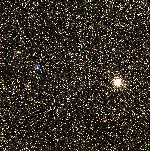 |
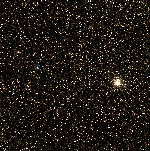 |
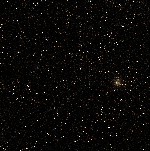 |
| Imax=1.50 | Imax=3 | Imax=12 |
SBIG ST-4K with 8″ f/6 Newtonian, 735s total exposure 9/27/19 Lake San Antonio, CA
This image shows two unrelated deep-sky objects that happen to appear close together in the sky. IC 1295, the blue object on the left, is a planetary nebula approximately 3300 ly distant. NGC 6712, the globular star cluster on the right, is much farther away, approximately 22500 ly. Visually, the globular cluster was easy to find, while IC 1295 was difficult to see at all. I only managed to get about two and a half 300s exposures before the sky clouded over at around 11pm.
IC 2149
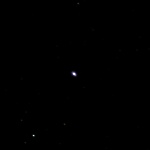 |
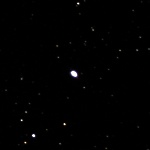 |
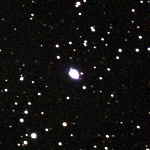 |
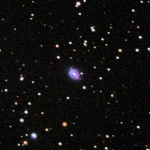 |
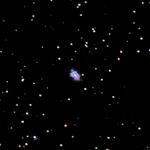 |
| Imax=200 | Imax=20 | Imax=1 | Nonlinear | Deconvolved, nonlinear |
SBIG ST-4K with C14 + f/7 reducer, 900s total exposure 9/23/22 Lake San Antonio, CA
Another small planetary nebula in Auriga. There appears to be a central ray or jet that is visible in the nonlinearly scaled image.
M1-92
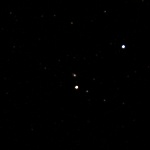 |
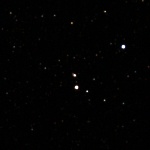 |
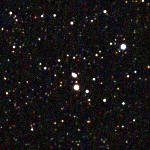 |
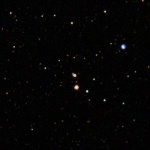 |
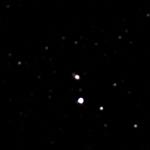 |
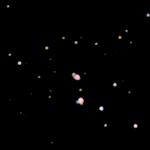 |
| Imax=300 | Imax=100 | Imax=10 | Nonlinear | Deconvolved | Deconvolved, nonlinear |
SBIG ST-4K with C14 + f/7 reducer, 100s total exposure 9/23/22 Lake San Antonio, CA
We had difficulty finding this small proto-planetary nebula in Cygnus—we nicknamed it "Tiny," and you can see why. We first had to use a sky atlas to correct the pointing, and then found that the object is quite bright. In this photo, the two lobes appear as a pair of barely separated star-like objects with unequal color and brightness.
Supernova Remnants
M1 - Crab Nebula
(all images of M1)
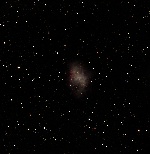 |
 |
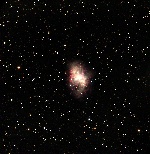 |
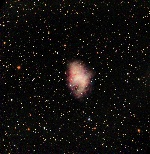 |
| pulsar marked | Imax=6 | Imax=2 | Nonlinear |
SBIG ST-4K with C14 + f/7 reducer, 1800s total exposure 10/08/21 Lake San Antonio, CA
This was our latest attempt at imaging the famous supernova remnant in Taurus. The later frames were affected by dew on the corrector plate, with the signal dropping by about a factor of 2 by the time of the last exposure. Comparing this image with old photographs in Burnham's, I can see some outward movement of the tentacles!
NGC 6960 - Veil Nebula (west half)
(all images of the Veil Nebula)
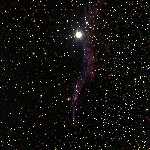 |
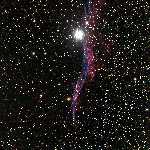 |
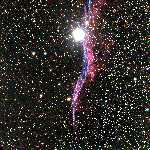 |
| Imax=2 | Imax=1 | Imax=0.5 |
SBIG ST-4K with 8″ f/6 Newtonian, 1800s total exposure 9/13/12 Lake San Antonio, CA
Obtaining good-quality images of the Veil Nebula has been an ongoing project, but the images shown here are the best so far. Even with the larger area CCD, we can only image part of it in a single exposure. The portion shown here includes the bright star 52 Cygni.
NGC 6992/5 - Veil Nebula (east half)
(all images of the Veil Nebula)
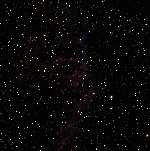 |
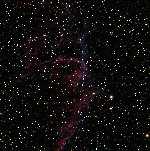 |
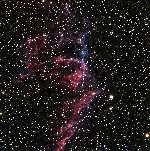 |
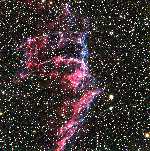 |
| Imax=5 | Imax=2.5 | Imax=1 | Imax=0.5 |
SBIG ST-4K with 8″ f/6 Newtonian, 1800s total exposure 9/13/12 Lake San Antonio, CA
Here is another portion with a more complicated structure.
NGC 6992 - Eastern Veil Nebula
(all images of the Veil Nebula)
 |
| Imax=1.50 |
SBIG ST-4K with C14 at f/7, 1800s total exposure 10/03/24 Lake San Antonio, CA
This is a close-up of one of the brightest and most intricate portions of the Veil Nebula.
IC 443
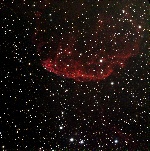 |
| Imax=1 |
SBIG ST-4K with 8″ f/6 Newtonian, 2700s total exposure 9/26/14 Lake San Antonio, CA
IC443 is a supernova remnant in Gemini with a rich filamentary structure. We were not sure what to expect when we decided to image it, and we ended up centering on the brightest edge.
Stars and Open Clusters
Barnard's Star
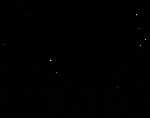 |
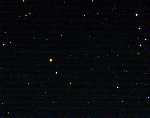 |
| Imax=1000 | Imax=100 |
Starshoot DSCI with 8″ f/6 Newtonian, 6 exposures, 10s each 9/25/08 Lake San Antonio, CA
This is the second-closest star system to our own, and the closest one that is observable from our latitude. This is a red dwarf star, with only 1/2500th the luminosity of the Sun. Distance: 5.94 ly (compared with 4.22 ly for Proxima Centauri). Magnitude: 9.54. Spectral type: M5. In this image, it is the bright orangish spot to the left of center.
Lalande 21185
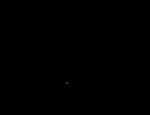 |
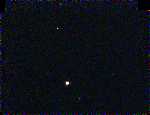 |
| Imax=10000 | Imax=100 |
Starshoot DSCI with 8″ f/6 Newtonian, 297 exposures, 1s each 12/29/08 Phoenix, AZ
This is another nearby red dwarf star, at a distance of 8.31 light years. It is called BD +36°2147 in the Observer's Handbook and is visible most of the year.
Epsilon Eridani
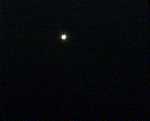 |
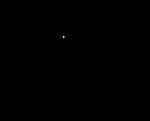 |
| Imax=500 | Imax=10000 |
Starshoot DSCI with 8″ f/6 Newtonian, 59 exposures, 1s each 9/25/08 Lake San Antonio, CA
This is another nearby star. Distance: 10.5 ly. Magnitude: 3.7. Luminosity: 1/3 that of the Sun. Spectral type: K2.
61 Cygni
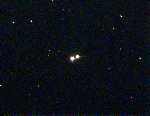 |
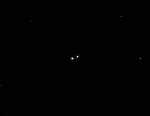 |
| Imax=200 | Imax=2000 |
Starshoot DSCI with 8″ f/6 Newtonian, 55 exposures, 1s each 9/17/09 Lake San Antonio, CA
61 Cygni is a magnitude 5 double star in Cygnus, famous for being the first star whose parallax was measured. This was accomplished by F. W. Bessel in 1838 using visual observation techniques, before photography existed! Distance: 11.4 ly. Individual magnitudes (A,B): 5.20, 6.05. Luminosities: only 0.065 and 0.038 compared with the Sun. Spectral types (A,B): K5, K7.
Alpha Centauri System
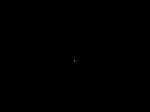 |
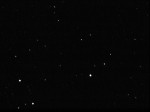 |
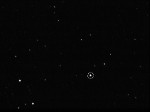 |
| α Cen A and B | Proxima | Proxima (circled) |
Alvium 1800 U-319m with 10″ LX200 telescope 2/22/23 Whangaparaoa, NZ
At a distance of 4.3 ly, the α Centauri system is the closest star system to our own, and it will continue to be for the next 30,000 years. It consists of two sun-like stars A and B and the red dwarf star Proxima. A and B, shown on the left, form a double-star system with a 79-year orbital period, with A approximately three times brighter than B. From the image, I would estimate a separation of approximately 9 arcsec, though the expected current separation is approximately 7.5 arcsec (and increasing), so it is possible the effective focal length at the camera position I used was different than expected. Proxima is physically quite far from A and B, approximately 0.2 ly, with an estimated orbital period of 547,000 years. It is so named because it is 0.1 ly closer to us than A and B. Because Proxima is rather faint (11th magnitude) and more than 2° away from A and B in the sky, it is difficult to identify Proxima amongst the background stars. In the right-most image, I circled the star that I believe is Proxima based on comparison with other images. Another way to confirm its identity would be to image the same field a year or more later, at which time the proper motion should be clearly visible.
S Cephei
 |
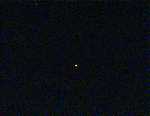 |
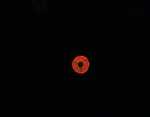 |
| Imax=75000 | Imax=1000 | defocused |
Starshoot DSCI with 8″ f/6 Newtonian, 93 exposures, 0.2s each 7/10/10 Adin, CA
This star in Cepheus is of spectral class N, and has a rather striking red-orange color, much more so than stars like Betelgeuse and Antares. In the image on the right, the star is defocused to allow its color to be more easily displayed (the black circle in the middle is the shadow of the secondary mirror).
β and DY Crucis
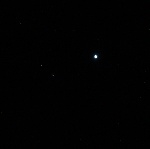 |
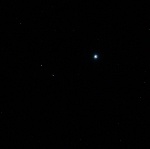 |
| Imax=660 | Nonlinear |
SBIG ST-4K with 10″ LX200 telescope, 20s total exposure 2/20/23 Whangaparaoa, NZ
DY ("Ruby") Crucis is a carbon star near Beta Crucis. Visually, the color was quite red. In this image, made by combining 20 1-second exposures, the usual linear scaling (left) results in an orange-white color because of display saturation. However, with a hue-preserving histogram-equalization scaling (right), the color appears red-orange, and the contrast relative to β, which appears blue-white, is most striking.
η Carinae
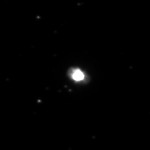 |
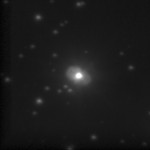 |
| Linear | Nonlinear |
Alvium 1800 U-319m with 10″ LX200 telescope, 300 x 1s exposures 2/16/23 Whangaparaoa, NZ
The star η Carinae, located near the brightest part of the Carina Nebula, is thought to be one of the most massive stars in our galaxy. From approximately 1837-1856, the star underwent the “Great Eruption” during which it briefly reached magnitude -1, becoming the second-brightest star in the sky. Afterwards it faded below naked-eye visibility, before slowly brightening again over the past 70 years to magnitude 4. Currently it is surrounded by a cloud of gas and dust known as the Homunculus Nebula, thought to be created by the event in the 1840s. Visually, it appears as two golden lobes very close to the star, which also has a golden color and is considerably brighter than the lobes. One of the lobes is brighter and easier to see than the other. I attempted to capture them using the monochrome CMOS camera to maximize resolution. The above images are stacked from 300 separate unguided exposures, using image registration and alignment. The image on the left is scaled linearly, while the image on the right uses a 1/4 power scaling to compress the dynamic range, making the shape of the lobes easier to see despite the large brightness disparities within the structure.
M11 - Wild Duck Cluster
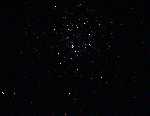 |
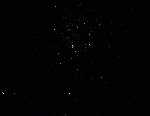 |
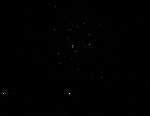 |
| Imax=400 | Imax=800 | Imax=1600 |
Starshoot DSCI with 8″ f/6 Newtonian, 299 exposures, 1s each 7/12/10 Adin, CA
This was a beautiful object in the eyepiece. Unfortunately, the computer display does not have adequate dynamic range to give a fair impression. There is some interesting color variation among the stars, but it is difficult to see without zooming in on the image.
M37
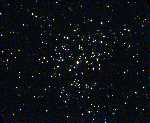 |
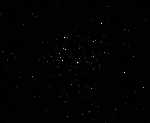 |
| Imax=50 | Imax=500 |
Starshoot DSCI with 8″ f/6 Newtonian, 53 exposures, 5s each 9/30/11 Lake San Antonio, CA
One of three open clusters (along with M36 and M38) in Auriga. Estimated distance: 4700 light years.
M52
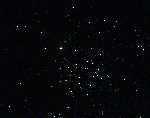 |
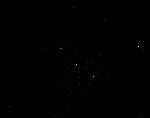 |
| Imax=100 | Imax=1000 |
Starshoot DSCI with 8″ f/6 Newtonian, 80 exposures, 5s each 9/29/11 Lake San Antonio, CA
Open cluster in Cassiopeia.
NGC 3293 - Gem Cluster
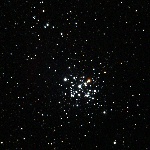 |
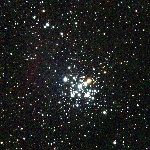 |
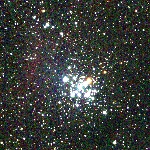 |
| Imax=4 | Imax=1 | Imax=0.50 |
SBIG ST-4K with 10″ LX200 telescope, 300s total exposure 2/20/23 Whangaparaoa, NZ
This cluster was challenging to find. After I finally confirmed a match with the sky atlas, I only had time for one exposure before the sky clouded over. Nevertheless, the color contrast between the stars can be seen, and some emission and reflection nebulae (to the left of the cluster) can also be seen faintly.
Globular Clusters
M9
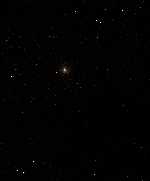 |
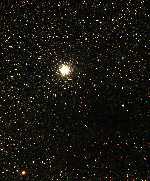 |
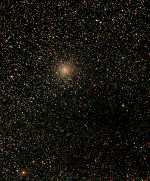 |
| Imax=30 | Imax=2 | Nonlinear |
SBIG ST-4K with 8″ f/6 Newtonian, 1500s total exposure 7/8/13 Adin, CA
This is a globular cluster in Ophiuchus that is positioned near the plane of the Milky Way. The idea here was to try to catch M9 and the dark nebula B64 in the same image. Comparing with other images, it looks like we captured part of the dark nebula in the lower-right part of this image, but the darkest patch is outside the field of view to the right.
M10
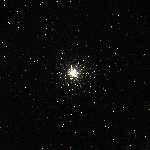 |
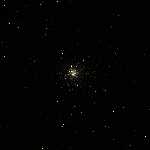 |
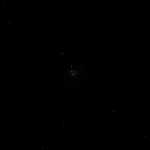 |
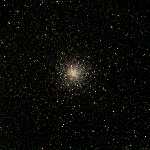 |
| Imax=5 | Imax=20 | Imax=150 | Nonlinear |
SBIG ST-4K with 8″ f/6 Newtonian, 300s total exposure 7/6/13 Adin, CA
This is a nice globular cluster in Ophiuchus. In the "nonlinear" image, the intensity is scaled logarithmically while the color ratios (hues) are preserved, allowing the star colors to be seen more easily. It appears that many of the brightest stars in the cluster are either very "red" (actually orange) or blue.
M13 - Hercules Cluster
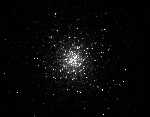 |
| see notes |
Starshoot DSCI with 8″ f/6 Newtonian, 9 exposures, 10s each 6/6/08 San Jose, CA
This was one of my first attempts at a deep sky object. 9 images were combined using the MaxIm softare that came with the camera. In the process, the color information was lost, so this is a black-and-white image.
M15
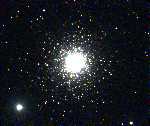 |
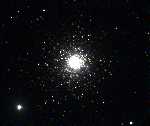 |
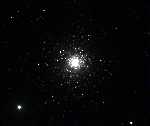 |
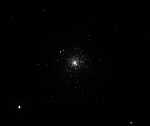 |
| Imax=20 | Imax=50 | Imax=100 | Imax=500 |
Starshoot DSCI with 8″ f/6 Newtonian, 69 exposures, 10s each 9/30/11 Lake San Antonio, CA
Compact globular cluster in Pegasus, approximately 40000 light years distant.
M22
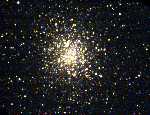 |
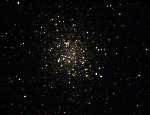 |
| Imax=50 | Imax=200 |
Starshoot DSCI with 8″ f/6 Newtonian, 16 exposures, 10s each 9/27/08 Lake San Antonio, CA
This is a nice globular cluster but was rather low in the sky. Most of the images were blurry, but some were relatively clear. To obtain this image, only the best 16 out of 52 exposures were combined.
M56
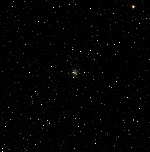 |
| Imax=18 |
SBIG ST-4K with 8″ f/6 Newtonian, 900s total exposure 9/27/14 Lake San Antonio, CA
We shouldn't forget to look at a new globular cluster every now and then.
NGC 5139 - Omega Centauri
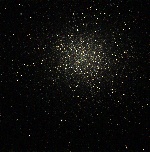 |
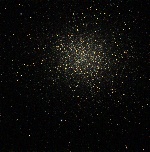 |
| Imax=20 | Nonlinear |
SBIG ST-4K with 10″ LX200 telescope, 160s total exposure 2/16/23 Whangaparaoa, NZ
Omega Centauri is the largest globular cluster in our galaxy and one of the most visually spectacular. However, at a declination of -47°, it barely rises above the horizon in southern states such as Arizona, and it is better observed from the Southern Hemisphere. This image was made from a sequence of 16 unguided exposures, each 10 seconds.
NGC 6440
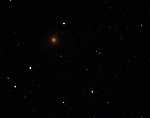 |
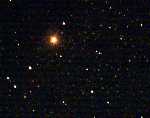 |
| Imax=100 | Imax=20 |
Starshoot DSCI with 8″ f/6 Newtonian, 5 exposures, 30s each 9/26/08 Lake San Antonio, CA
This is a globular cluster in the same eyepiece field as NGC 6445. The orange color is real-- apparently there is a lot of galactic dust obscuring this object.
Galaxies
M31 - Andromeda Galaxy
(all images of M31)
 |
 |
 |
 |
 |
| Imax=160 | Imax=20 | Imax=2.50 | Imax=1 | Nonlinear |
SBIG ST-4K with 8″ f/6 Newtonian, 3000s total exposure 9/26/14 Lake San Antonio, CA
This was an attempt to image all of M31 through a mosaic of three exposure locations. We captured most of it, but perhaps could have benefitted from an even larger field of view. The most interesting parts to me are along the outer edge, where individual blue stars and a few nebulae can be seen.
NGC 206 in M31
(all images of M31)
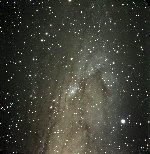 |
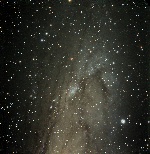 |
| Imax=1 | Nonlinear |
SBIG ST-4K with 8″ f/6 Newtonian, 3900s total exposure 10/3/13 Lake San Antonio, CA
This is a new attempt to capture the star clouds along the southern end of M31, including NGC 206 (the brightest patch). Numerous blue supergiant stars (and a few pink nebulae) can be seen, but the focus could have been better.
NGC 205 (Companion of M31)
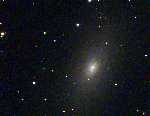 |
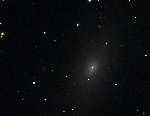 |
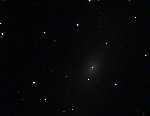 |
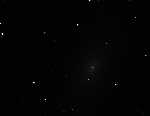 |
| Imax=10 | Imax=20 | Imax=40 | Imax=80 |
Starshoot DSCI with 8″ f/6 Newtonian, 66 exposures, 20s each 10/7/10 Lake San Antonio, CA
The Andromeda Galaxy has two companions that appear prominently in many photographs, M32 (NGC 221) and NGC 205, shown here. NGC 205 is the more distant (from M31) of the two. Notice the bright, star-like nucleus, and the dust clouds.
M32 (Companion of M31)
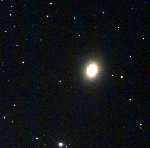 |
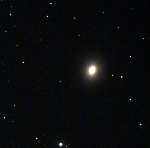 |
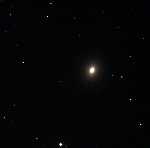 |
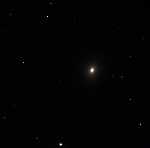 |
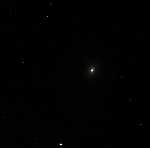 |
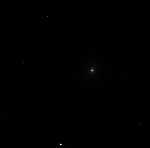 |
| Imax=20 | Imax=40 | Imax=80 | Imax=160 | Imax=320 | Imax=640 |
Starshoot DSCI with 8″ f/6 Newtonian, 27 exposures, 20s each 10/7/10 Lake San Antonio, CA
M32 (NGC 221) is the closest and brightest of the satellites of M31. This galaxy appears highly concentrated, with an extremely bright star-like nucleus. In these images it appears that M32 has a nucleus even brighter than that of M31.
M33 - Triangulum Galaxy
(all images of M33)
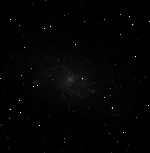 |
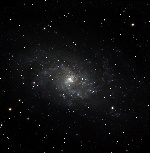 |
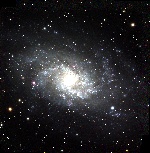 |
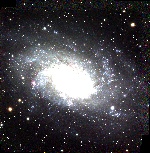 |
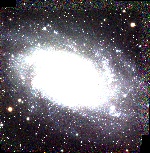 |
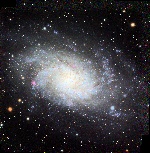 |
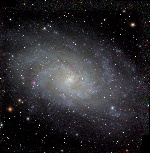 |
| Imax=12 | Imax=3 | Imax=1 | Imax=0.50 | Imax=0.25 | Nonlinear | Nonlinear |
SBIG ST-4K with 8″ f/6 Newtonian, 9300s total exposure 9/22/17 Whisper Canyon, CA
At a distance of 3 million light years, M33 is one of the nearest galaxies, about the same distance as Andromeda. It is, in my opinion, the most spectacular of all the galaxies for imaging, since it is possible to resolve a large number of individual stars and nebulae. The brightest emission nebula, appearing to the left of center, is NGC 604. For the image above, we attempted to get a deeper exposure of M33 (compared with 9/13/12) to see more of the interesting features around the periphery. After discarding a few frames with tracking problems, we ended up with 31 5-minute exposures. There are some regions around the edges that appear more grainy since they have less exposure. I chose not to crop them for increased coverage.
M51 - Whirlpool Galaxy
(all images of M51)
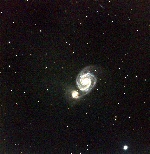 |
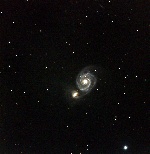 |
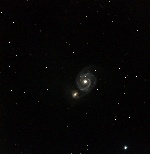 |
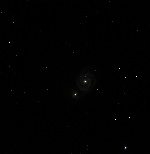 |
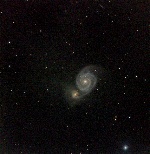 |
| Imax=1 | Imax=2 | Imax=4 | Imax=16 | Nonlinear |
SBIG ST-4K with 8″ f/6 Newtonian, 2400s total exposure 5/30/14 Monte Bello, CA
M51 was almost straight overhead, but the air was very humid with dew forming on everything. There was fog in the valley even at sunset, and we were wondering if it would reach the Monte Bello parking lot. After about 45 minutes of exposure the fog finally came in and we had to stop.
M61
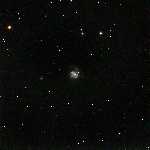 |
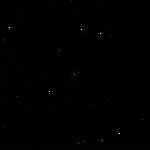 |
| Imax=2.5 | Imax=32 |
SBIG ST-4K with 8″ f/6 Newtonian, 1500s total exposure 4/12/13 Monte Bello Open Space Preserve, CA
Nice face-on spiral in Virgo cluster, with a few bonus galaxies. Note the lumpy, crooked arms. This is one of Kathy's picks.
M63 - Sunflower Galaxy
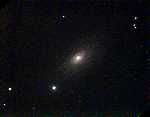 |
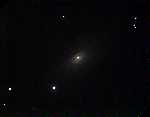 |
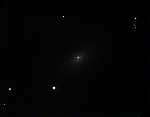 |
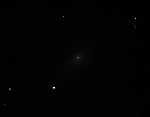 |
| Imax=20 | Imax=40 | Imax=80 | Imax=160 |
Starshoot DSCI with 8″ f/6 Newtonian, 56 exposures, 30s each 6/5/10 Palo Alto, CA
This galaxy is in Canes Venatici, not far (in the sky) from the Whirlpool galaxy, and was taken from our local park under a rather bright sky. The spiral arms have a texture that I have not seen before.
M64 - Black Eye Galaxy
(all images of M64)
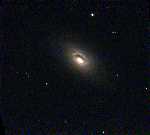 |
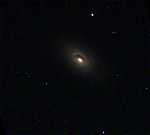 |
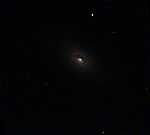 |
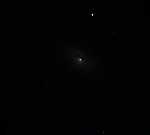 |
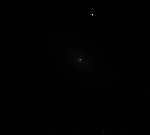 |
| Imax=15 | Imax=30 | Imax=60 | Imax=120 | Imax=240 |
Starshoot DSCI with 8″ f/6 Newtonian, 52 exposures, 20s each 7/12/10 Adin, CA
I tried to spot the 'eye' visually, but I was not sure if I could see it. This is suprising considering how obvious it is in the photograph.
M65 and M66
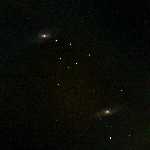 |
| Imax=10 |
SBIG ST-4K with 8″ f/6 Newtonian, 1232.532s total exposure 5/13/12 Palo Alto, CA
First attempt at M65 (lower-right) and M66 (upper-left), from the front porch. The sky suddenly clouded over after about 20 minutes of exposures.
M66
 |
 |
 |
 |
| Imax=50 | Imax=100 | Imax=200 | Imax=400 |
Alvium 1800 U-319m with C14 at f/7, 30 x 10s 5/2/24 Palo Alto, CA
A more recent, brief exposure of M66 from our back yard.
M74
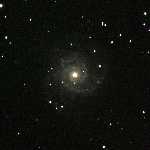 |
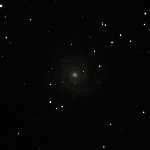 |
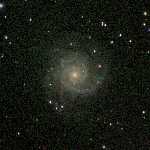 |
| Imax=2 | Imax=6.5 | Nonlinear |
SBIG ST-4K with 8″ f/6 Newtonian, 2100s total exposure 7/7/13 Adin, CA
A nice side-effect of the time we have spent on imaging over the past few years is that it has pushed us to look at new objects that we never bothered to look for in the past, and M74 is one such object--chosen by Kathy. This is a rather faint galaxy, though, and was not very high in the sky when we took this image (and it was starting to get light out).
M77
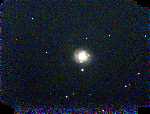 |
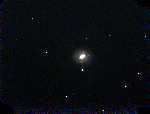 |
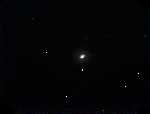 |
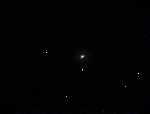 |
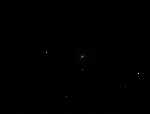 |
 |
| Imax=10 | Imax=25 | Imax=75 | Imax=150 | Imax=500 | Imax=1000 |
Starshoot DSCI with 8″ f/6 Newtonian, 125 exposures, 10s each 9/18/09 Lake San Antonio, CA
A spiral galaxy in Cetus. It has a star-like nucleus as can be seen in the above sequence. This galaxy has some very faint outer structure that is barely hinted at in the image on the left.
M81
(all images of M81)
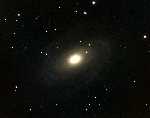 |
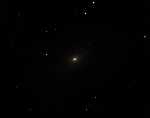 |
| Imax=5 | Imax=50 |
SBIG ST-4K with 8″ f/6 Newtonian, 3600s total exposure 1/13/12 Palo Alto, CA
This is my first attempt to obtain a real image with the ST-4K camera. This was from our patio, so the lighting conditions were very bad, with a bright sky and a nearby lamp shining directly onto the telescope. This was with autoguiding- two 1200s exposures and four 300s exposures.
M82
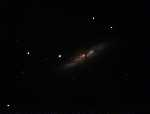 |
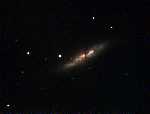 |
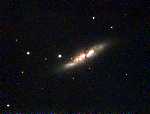 |
| Imax=80 | Imax=40 | Imax=20 |
Starshoot DSCI with 8″ f/6 Newtonian, 52 exposures, 30s each 6/5/10 Palo Alto, CA
This is the so-called "exploding galaxy" in Ursa Major. The unusual redish clumps in the middle are supposed to be regions of intensive star formation. This image and several others were taken from a local park. Some guys were camped out in a motorhome nearby and doing weird things.
M84, M86, and others
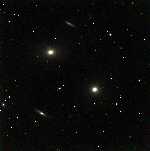 |
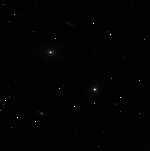 |
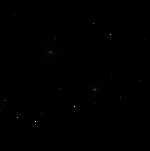 |
| Imax=2 | Imax=10 | Imax=40 |
SBIG ST-4K with 8″ f/6 Newtonian, 1800s total exposure 5/11/13 Bonny Doon, CA
This image shows part of the Virgo cluster. The two bright elliptical galaxies are M86 (upper-left) and M84 (lower-right). The two bright edge-on galaxies are NGC 4388 (bottom-left) and NGC 4402 (top).
M87 and NGC4478
(all images of M87)
 |
 |
 |
 |
| Imax=50 | Imax=100 | Imax=200 | Imax=400 |
Alvium 1800 U-319m with C14 at f/7, 60 x 10s 5/10/24 Palo Alto, CA
A more recent exposure of M87 from our patio. Though monochrome, this image clearly shows the jet that is thought to be associated with a black hole. NGC4478 is visible to the right.
M88
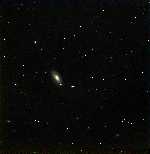 |
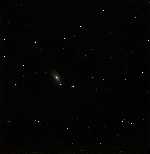 |
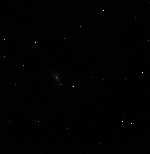 |
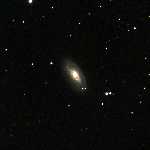 |
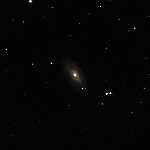 |
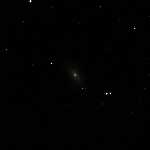 |
| Imax=2 | Imax=5 | Imax=15 |
SBIG ST-4K with 8″ f/6 Newtonian, 1800s total exposure 5/11/13 Bonny Doon, CA
Bright spiral galaxy in Virgo cluster. Top row: full frame. Botton row: cropped.
M90
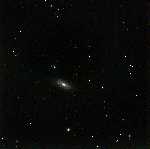 |
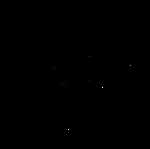 |
| Imax=2.5 | Imax=68 |
SBIG ST-4K with 8″ f/6 Newtonian, 1731s total exposure 4/12/13 Monte Bello Open Space Preserve, CA
Spiral galaxy in Virgo. The small streak in front of the galaxy is from some faint, unidentified object that was slowly moving during the ~30 minutes of exposures. The nucleus of this galaxy is quite bright.
M98
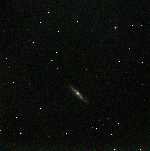 |
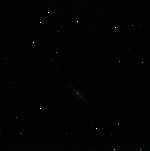 |
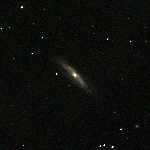 |
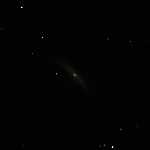 |
| Imax=2 | Imax=10 |
SBIG ST-4K with 8″ f/6 Newtonian, 900s total exposure 5/11/13 Bonny Doon, CA
Spiral galaxy in Coma Berenices. Limited exposures due to battery problems. Top row: full frame. Botton row: cropped.
M100
 |
 |
 |
 |
| Imax=50 | Imax=100 | Imax=200 | Imax=400 |
Alvium 1800 U-319m with C14 at f/7, 120 x 10s 5/10/24 Palo Alto, CA
Another spiral galaxy in the Virgo cluster (Coma Berenices), captured from our patio. The outer arms are faint, but the spiral structure continues all the way to the bright center.
M101
(all images of M101 and supernova SN 2011fe)
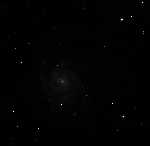 |
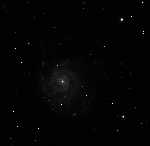 |
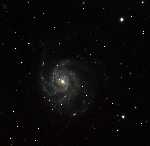 |
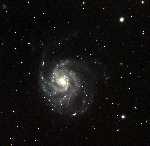 |
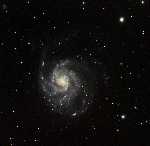 |
| Imax=10 | Imax=5 | Imax=2 | Imax=1 | Nonlinear |
SBIG ST-4K with 8″ f/6 Newtonian, 2934s total exposure 7/6/13 Adin, CA
The supernova is no longer visible. This was our first image from GSSP in 2013.
M104 - Sombrero Galaxy
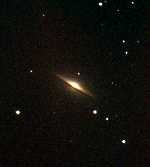 |
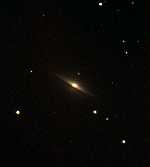 |
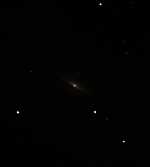 |
| Imax=5 | Imax=10 | Imax=50 |
SBIG ST-4K with 8″ f/6 Newtonian, 300s total exposure 6/14/12 Monte Bello Open Space Preserve, CA
This is our first attempt at this unique galaxy. Unfortunately, by the time the clouds moved out of the way it was very low in the sky.
M106
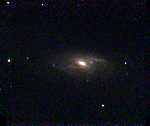 |
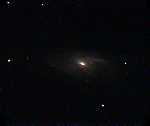 |
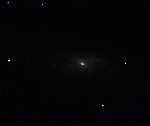 |
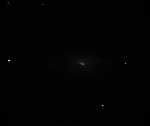 |
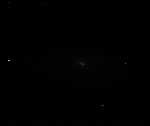 |
| Imax=15 | Imax=30 | Imax=60 | Imax=120 | Imax=240 |
Starshoot DSCI with 8″ f/6 Newtonian, 38 exposures, 20s each 7/13/10 Adin, CA
This is a bright spiral galaxy in Canes Venatici.
Andromeda I
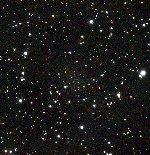 |
| Imax=0.25 |
SBIG ST-4K with 8″ f/6 Newtonian, 4500s total exposure 9/28/19 Lake San Antonio, CA
Andromeda I is one of a number of satellite galaxies of our galactic neighbor M31 (the Andromeda Galaxy). According to Wikipedia, it was discovered only in 1970. Since it was much too faint to see visually, I found it by star hopping, using the chart in Sky Safari. Even in a 5-minute exposure it was difficult to tell if the image contained anything other than stars. Here, the galaxy is visible as a faint but perceptible glow in the center of the image.
Andromeda III
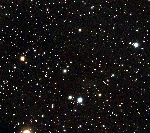 |
| Imax=0.25 |
SBIG ST-4K with 8″ f/6 Newtonian, 4800s total exposure 9/8/18 Lake San Antonio, CA
This extremely faint galaxy (the faint cloud below-right of center) is another companion of the Andromeda Galaxy.
NGC 147
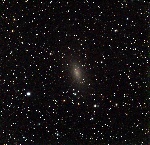 |
| Imax=1 |
SBIG ST-4K with 8″ f/6 Newtonian, 2700s total exposure 9/21/17 Whisper Canyon, CA
NGC 147 in Cassiopeia, at an estimated distance of 2.5 million light years, is a close companion of NGC 185 and also considered a satellite of Andromeda. It has a low surface brightness, and we could not see it visually.
NGC 185
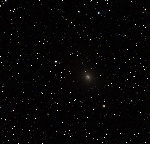 |
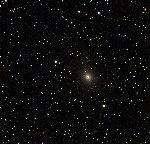 |
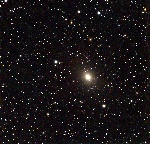 |
| Imax=4 | Imax=2 | Imax=1 |
SBIG ST-4K with 8″ f/6 Newtonian, 1800s total exposure 9/21/17 Whisper Canyon, CA
NGC 185 in Cassiopeia, at an estimated distance of 2.1 million light years, is a close companion of NGC 147 and is also considered a satellite of Andromeda.
NGC 253
(all images of NGC 253)
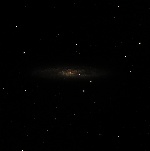 |
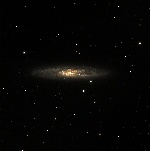 |
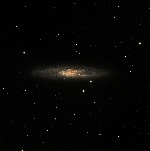 |
| Imax=10 | Imax=3 | Nonlinear |
SBIG ST-4K with 8″ f/6 Newtonian, 3000s total exposure 9/27/14 Lake San Antonio, CA
Here is NGC 253 in all its glory, a giant peppermint candy swirl of star-stuff and galactic dust. This is one of the (apparently) largest and brightest galaxies, but it is also rather far south (declination -25°). With the new camera we were finally able to capture the entire galaxy in a single exposure.
NGC 255
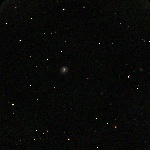 |
 |
| Imax=2 | Imax=1 |
SBIG ST-4K with C14 at f/7, 600s total exposure 10/03/24 Lake San Antonio, CA
I found this barred spiral galaxy in Cetus by accident while looking for NGC 246. A number of fainter galaxies are scattered across the frame as well. (The problem in the upper corners is due to condensation in the camera, with the dessicant needing replacement, but I chose not to crop this image because of some interesting galaxies near the upper edge.)
NGC 278
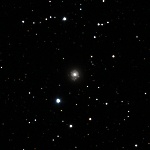 |
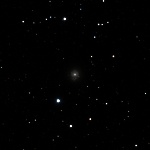 |
| Imax=7.50 | Imax=18.50 |
SBIG ST-4K with 8″ f/6 Newtonian, 900s total exposure 10/5/13 Lake San Antonio, CA
This is a small face-on spiral galaxy in Cassiopeia. This tiny, pearl-like galaxy is one of Kathy's picks.
NGC 891
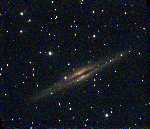 |
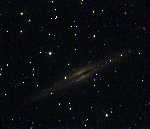 |
| Imax=7.5 | Imax=15 |
Starshoot DSCI with 8″ f/6 Newtonian, 38 exposures, 30s each 10/1/11 Lake San Antonio, CA
This is an edge-on galaxy in Andromeda with a prominent dust lane appearing in photographs. Visually, the galaxay appeared as a faint streak of light, and the dust lane was impossible to discern.
NGC 1300
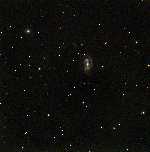 |
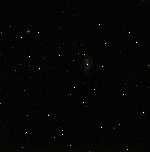 |
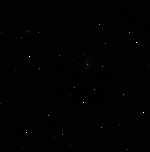 |
| Imax=1 | Imax=3 | Imax=10 |
SBIG ST-4K with 8″ f/6 Newtonian, 1800s total exposure 9/15/12 Lake San Antonio, CA
This galaxy in Eridanus has a striking barred structure. It was rather low in the sky, so that the increased sky glow and possibly reduced transparency were factors. We wanted to take more exposures but ran out of battery power.
NGC 4565
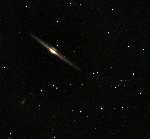 |
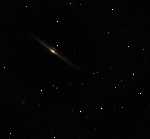 |
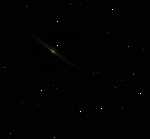 |
| Imax=2 | Imax=5 | Imax=10 |
SBIG ST-4K with 8″ f/6 Newtonian, 2100s total exposure 7/14/12 Monte Bello Open Space Preserve, CA
This is a nearly edge-on galaxy in Coma Berenices with a bright nucleus peaking around its dark lane. The image boundaries were chosen to include a number of much fainter galaxies.
NGC 5128 - Centaurus A
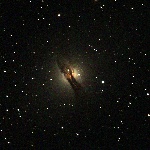 |
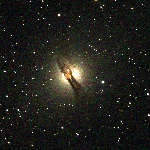 |
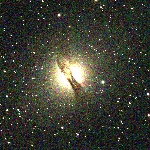 |
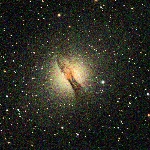 |
| Imax=2 | Imax=1 | Imax=0.50 | Nonlinear |
SBIG ST-4K with 10″ LX200 telescope, 300s total exposure 2/17/23 Whangaparaoa, NZ
Centaurus A is famous both as a radio source and for its striking dust lane, resulting from the merger of a spiral galaxy with an elliptical galaxy. In this photo, I only managed to acquire one frame before the sky clouded over, and already the telescope's corrector plate had a lot of condensation. Nevertheless, the main structures can be seen.
NGC6207
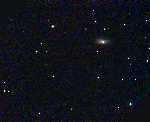 |
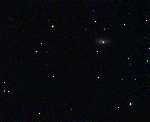 |
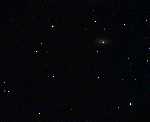 |
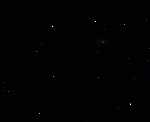 |
| Imax=10 | Imax=20 | Imax=30 | Imax=100 |
Starshoot DSCI with 8″ f/6 Newtonian, 34 exposures, 30s each 7/11/10 Adin, CA
This galaxy is very close to M13, and was one of Kathy's picks.
NGC 6822 - Barnard's Galaxy
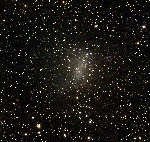 |
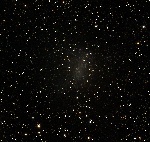 |
| Imax=0.70 | Imax=1.70 |
SBIG ST-4K with 8″ f/6 Newtonian, 3600s total exposure 10/5/13 Lake San Antonio, CA
At a distance of 1.6 million light years, NCG 6822 is one of the closest galaxies visible from our latitude. This small, irregular galaxy contains numerous emission nebulae, the brightest of which can be seen here. Numerous stars can be resolved, as well. The bubble-like feature at upper-right from center seems particular striking and appears similar to a feature in M33 (on the left edge of the M33 image, at about 9:30).
NGC 6946
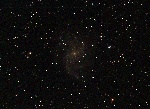 |
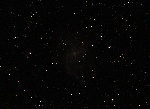 |
| Imax=2 | Imax=5 |
SBIG ST-4K with 8″ f/6 Newtonian, 572s total exposure 9/11/15 Whisper Canyon, CA
Spiral galaxy in Cygnus, heavily reddened by dust in our own galaxy.
NGC 7317-20
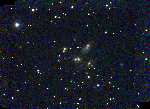 |
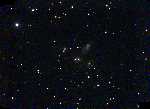 |
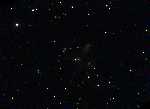 |
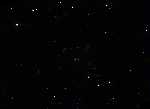 |
| Imax=5 | Imax=10 | Imax=20 | Imax=50 |
Starshoot DSCI with 8″ f/6 Newtonian, 50 exposures, 30s each 9/30/11 Lake San Antonio, CA
This famous galaxy cluster in Pegasus, known as Stephan's Quintet, is >200 million light years distant. However, the brightest galaxy (NGC 7320) is apparently much closer (40 million light years).
NGC 7331
(all images of NGC 7331)
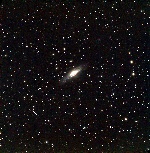 |
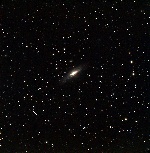 |
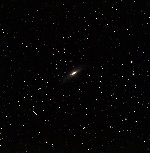 |
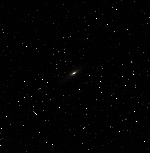 |
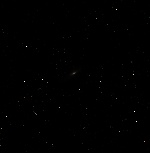 |
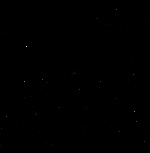 |
| Imax=1 | Imax=2 | Imax=4 | Imax=8 | Imax=32 | Imax=128 |
SBIG ST-4K with 8″ f/6 Newtonian, 1800s total exposure 9/23/17 Whisper Canyon, CA
NGC 7331 is a spiral galaxy in Pegasus, approximately 40 light-years from us. This was an attempt to get a deeper exposure compared with the previous Starshoot image. Based on the results, it appears that even more exposure time would have helped. Some of the images I have seen online of this galaxy are processed beyond recognition, but the HST images are quite impressive. This image also shows a multitude of more distant galaxies.
NGC 7600
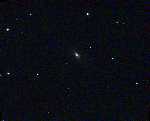 |
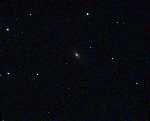 |
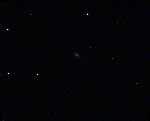 |
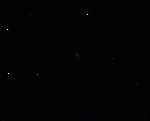 |
| Imax=15 | Imax=20 | Imax=50 | Imax=100 |
Starshoot DSCI with 8″ f/6 Newtonian, 14 exposures, 30s each 10/1/11 Lake San Antonio, CA
This is an elliptical galaxy in Aquarius, not far from NGC 7606. Visually, it appeared as just a small, faint fuzz patch.
NGC 7606
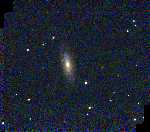 |
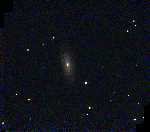 |
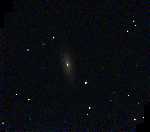 |
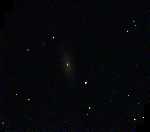 |
| Imax=5 | Imax=10 | Imax=15 | Imax=25 |
Starshoot DSCI with 8″ f/6 Newtonian, 35 exposures, 30s each 9/30/11 Lake San Antonio, CA
This is a spiral galaxy in Pegasus that Kathy chose from the star chart.
NGC 7814
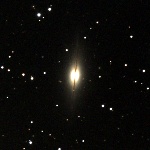 |
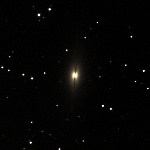 |
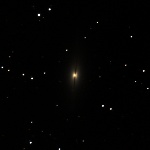 |
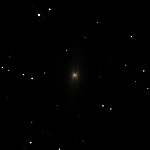 |
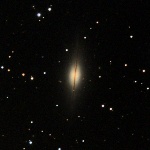 |
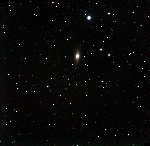 |
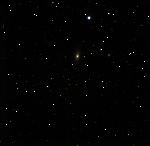 |
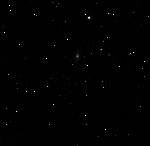 |
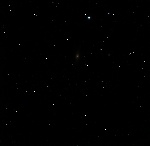 |
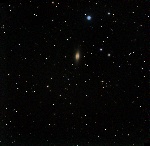 |
| Imax=1 | Imax=3 | Imax=6 | Imax=10 | Nonlinear |
SBIG ST-4K with 8″ f/6 Newtonian, 3600s total exposure 10/4/13 Lake San Antonio, CA
This is a spectacular edge-on spiral galaxy in Pegasus. Numerous smaller, fainter galaxies can be seen as well (this is the reason for including the uncropped versions). A faint, slow-moving object appears as a broken streak near a bright star in the lower-right part of the full-sized image. Based on its slow motion, it might be an asteroid (see Ceres below).
IC 10
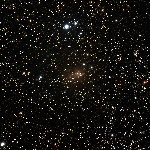 |
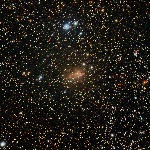 |
| Imax=1 | Nonlinear |
SBIG ST-4K with 8″ f/6 Newtonian, 2669s total exposure 10/5/13 Lake San Antonio, CA
IC 10 is a small, irregular galaxy in the constellation Cassiopeia. It is a member of our local group, and its distance, 2.8 million light years, is similar to that of the Andromeda and Triangulum galaxies. This image shows dust lanes and pink clouds that are apparently large emission nebulae.
IC 342
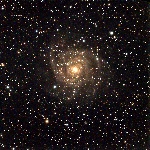 |
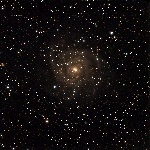 |
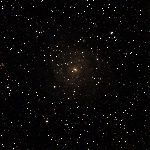 |
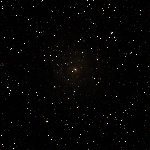 |
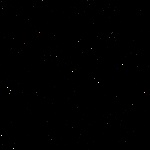 |
| Imax=0.50 | Imax=1 | Imax=2 | Imax=4 | Imax=80 |
SBIG ST-4K with 8″ f/6 Newtonian, 6000s total exposure 9/7/18 Lake San Antonio, CA
IC 342 is a large spiral galaxy in Camelopardalis, reddened by dust in the Milky Way.
UGC6
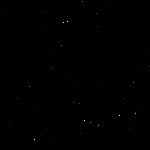 |
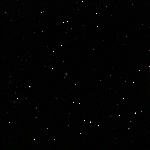 |
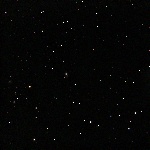 |
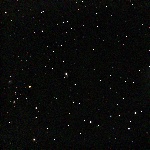 |
| Imax=20 | Imax=4 | Imax=2 | Imax=1 |
SBIG ST-4K with C14 + f/7 reducer, 1200s total exposure 10/09/21 Lake San Antonio, CA
Kathy chose this galaxy in Pisces from the Sky Safari catalog. It was also a good test of the mount's go-to alignment, and fortunately it was nearly centered in the camera to start out. The galaxy turned out to have an interesting shape with a visible spiral arm, and a number of other galaxies can be seen in the same field.
UGC 12613 - Pegasus Dwarf Irregular Galaxy
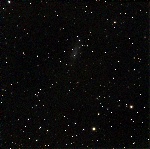 |
| Imax=0.70 |
SBIG ST-4K with 8″ f/6 Newtonian, 2700s total exposure 9/26/14 Lake San Antonio, CA
UGC 12613 is another nearby galaxy in our local group, at a distance of about 3 million light years, in the constellation Pegasus. It was too faint to see visually, and we had to search for it using test exposures. In this image we see only the brightest central portion, which appears as a faint smudge.
PGC 1642253 (near Abell 2626)
 |
| Imax=1.20 |
SBIG ST-4K with C14 at f/7, 1200s total exposure 10/05/24 Lake San Antonio, CA
This was a mostly unsuccessful attempt to capture the Abell 2626 galaxy cluster in Pegasus, after waiting several hours for the clouds to clear. The go-to pointing was slightly off-target, and at the time I could not match the stars in the camera field to the chart. Studying the image later, it turns out that the center of the cluster is beyond the top edge of the image. Nevertheless, some of the faint galaxies near the top of the image belong to the outskirts of the cluster, and many other faint galaxies are scattered across the image.
PGC 2265215
 |
| Imax=0.80 |
SBIG ST-4K with C14 at f/7, 2100s total exposure 10/04/24 Lake San Antonio, CA
This star field in Perseus includes galaxies PGC 2265215 (magnitude 17.4, 1/3 of the way down from the top border between two stars), PGC 2262555 (magnitude 16, near upper-right corner), and a number of fainter galaxies scattered across the image. These galaxies all appear quite small, but can be distinguished from stars by zooming into the image and looking for objects with a more fuzzy border. Some of the exposures combined into this image were affected by thin clouds.
Perseus Galaxy Cluster
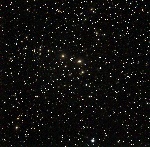 |
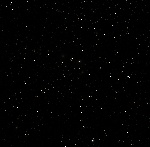 |
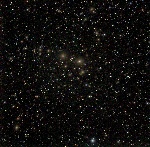 |
| Imax=1 | Imax=10 | Nonlinear |
SBIG ST-4K with 8″ f/6 Newtonian, 1800s total exposure 10/4/13 Lake San Antonio, CA
At an estimated distance of 240 million light years, this large galaxy cluster includes NGC 1275, which is the brightest galaxy in the image, slightly above-right from center. NGC 1275 is a strong source of radio and X-ray emission, and is thought to consist of two colliding galaxies. The resolution in this image is not good enough to see the dark lanes of the foreground galaxy clearly, though some hint of this structure can possibly be made out in the 'nonlinear' image by comparing with higher-resolution images.
Coma Berenices Galaxy Cluster
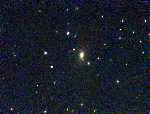 |
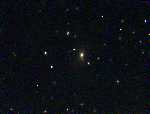 |
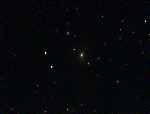 |
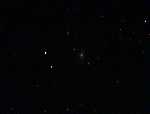 |
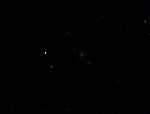 |
 |
| Imax=5 | Imax=10 | Imax=20 | Imax=40 | Imax=80 | Imax=10, circled |
Starshoot DSCI with 8″ f/6 Newtonian, 106 exposures, 20s each 7/13/10 Adin, CA
This image is centered on NGC 4889, an elliptical galaxy that is the brightest in the Coma cluster. A majority of the objects in the image are galaxies, at a distance of ~300-400 million light years. The cluster contains ~1000 galaxies in total. In the right-most image, objects that are definitely galaxies are circled, based on material from Albert Highe's website.
Corona Borealis Galaxy Cluster
(all images of the Corona cluster)
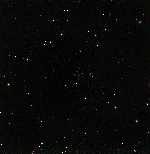 |
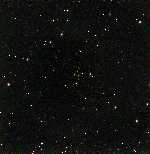 |
| Imax=2 | Imax=1 |
SBIG ST-4K with 8″ f/6 Newtonian, 1800s total exposure 7/14/12 Monte Bello Open Space Preserve, CA
This galaxy cluster, thought to be about 1 billion light years from us (z=0.072), is the most distant target we have imaged so far. If you zoom in on the central region of the image, most of the objects you see are galaxies. Comparing with the charts for Abell 2065 in Hoffman and Crane, Astrophys. J. 215 , 379 (1977), it appears that the faintest galaxies visible are about 19th magnitude.
NGC 4319 and Quasar Markarian 205
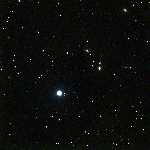 |
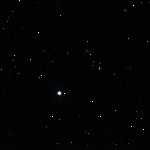 |
 |
| Imax=1.5 | Imax=7 | labeled |
SBIG ST-4K with 8″ f/6 Newtonian, 1200s total exposure 9/15/12 Lake San Antonio, CA
This was our first effort to image a quasar, Markarian 205 in Draco, next to NGC 4319. The image on the right has them labeled. The prevailing view is that NGC 4319 is in the foreground (92 million light years away) while Markarian 205 is far behind it, about 1 billion light years from us, based on its redshift. However, opponents of the big bang theory have argued that some photographs have shown a faint bridge connecting the two objects, and thus they should be at the same distance, despite their different redshifts. In our image, while the quasar appears bright, the resolution and exposure depth would not be sufficient to distinguish it from a foreground star.
NGC 6503 / Quasar 1749+701
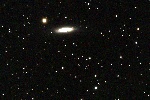 |
 |
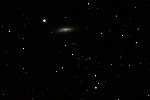 |
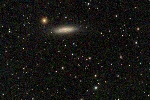 |
| circled | Imax=1 | Imax=6 | Nonlinear |
SBIG ST-4K with 8″ f/6 Newtonian, 1200s total exposure 9/10/15 Whisper Canyon, CA
Quasar 1749+701 (circled in the first image) has been identified as one of the BL Lacertae objects, a subclass of active galactic nuclei with spectrally broad emission, weak or absent atomic lines, polarized emission, and rapid temporal variability. Its estimated redshift is z=0.77, corresponding to a light travel time of approximately 7 billion years, half the age of the universe.
Solar System
Moon
 |
 |
 |
 |
| location 1, 50 frames | deconvolved | location 2, 50 frames | deconvolved |
Alvium 1800 U-319m with C5, 1/1/24 New River, AZ
These images show two locations on the Moon under typical conditions. Although thin clouds were present, the cloulds mostly produced a background offset in the images. The small, dark donut features that appear in a few locations are the shadows of dust on the camera sensor window.
Sun (partial eclipse)
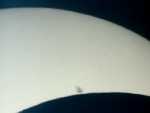 |
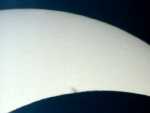 |
 |
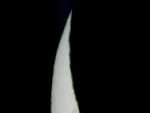 |
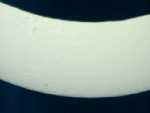 |
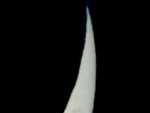 |
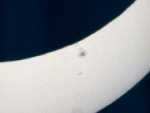 |
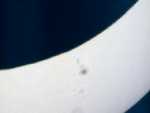 |
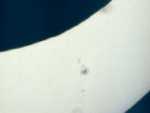 |
Philips SPC 900NC Webcam with 8″ f/6 Newtonian 5/20/12 Palo Alto, CA
These are pictures from the May 20 solar eclipse, which was annular in northern California. In Palo Alto, the moon was supposed to block about 89% of the sun's disk. Most of the details to be seen through the telescope were on the Sun, though the edge of the moon had noticeable bumps. Top row: the edge of the Moon covers a pair of sunspots. Middle row: portions of the Sun as seen near the eclipse maximum. Bottom row: the edge of the Moon uncovers another group of sunspots.
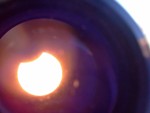 |
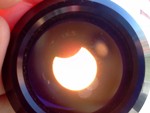 |
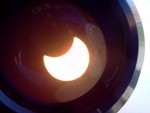 |
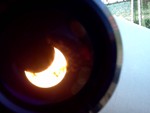 |
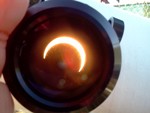 |
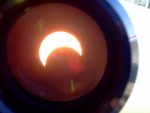 |
Pointing phone camera into eyepiece 5/20/12 Palo Alto, CA
These are Kathy's pictures of the eclipse that she took through the eyepiece using her smartphone camera.
Total solar eclipse
 |
 |
| single frame, 1/30 sec | single frame, 1/4000 sec |
 |
 |
 |
 |
| 3 x 1/30 sec | 6 x 1/250 sec | 2 x 1/1000 sec | 3 x 1/4000 sec |
 |
 |
 |
| 1/4000 sec, color stretched | combined (v1) | combined (v2) |
Canon EOS R7 at f/6.3, 150mm 4/8/2024 Cedar Hill, TX
Total eclipse photos from our trip to the Dallas area. Top row: two examples of uncropped, original frames. Middle row: results from stacking multiple exposures taken with the same settings. The longest exposure (1/30 sec) shows the large extent of the corona, while the shortest exposure (1/4000 sec) shows the pink prominences that extend just beyond the edge of the moon. Bottom row: more processed attempts to convey what we could see visually. For the color-stretched image, a linear color mapping was applied to increase the color saturation of the prominences. For the combined images, the three longer exposures were summed to create an extended corona image, which was then combined with the shortest exposure using a radially-weighted blend. For more details and other photos, see trip summary.
Sun
 |
 |
| best 30/100 frames | deconvolved |
Alvium 1800 U-319m with C5, 1/2/24 New River, AZ
This image shows the Sun under fairly typical conditions, with sunspots and other structures visible.
Venus
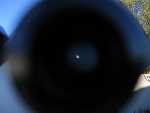 |
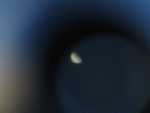 |
| zoomed out | zoomed in |
Pointing digital camera into eyepiece 1/1/09 Phoenix, AZ
I found Venus during the day and wanted to take a picture of it, but even the blue sky alone was too bright for the shortest exposures of the Orion Starshoot. Instead, I got these pictures by pointing a digital camera into the eyepiece. This was actually difficult because it is not possible to get much of the field view of the eyepiece into the camera's lens system, even with the lens right up against the eyepice. The size of Venus on this day should have been about 22 arcsec.
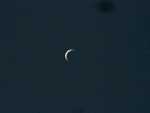 |
Philips SPC 900NC Webcam with 8″ f/6 Newtonian 5/20/12 Palo Alto, CA
Here is a thin crescent Venus as seen on the evening of the May 20 eclipse, 16 days before it transits the Sun.
Venus Transit
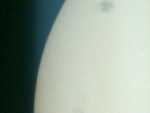 |
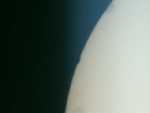 |
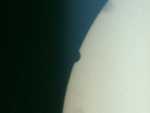 |
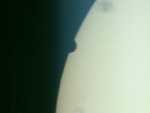 |
 |
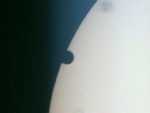 |
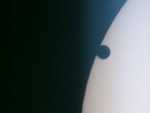 |
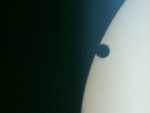 |
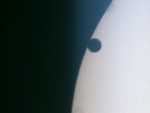 |
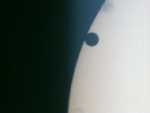 |
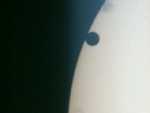 |
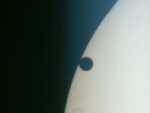 |
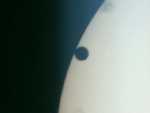 |
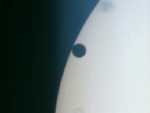 |
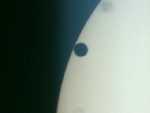 |
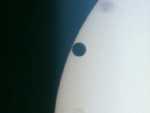 |
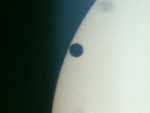 |
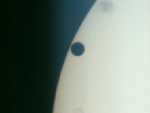 |
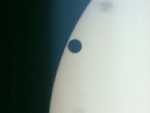 |
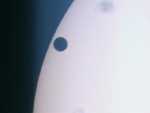 |
Philips SPC 900NC Webcam with 8″ f/6 Newtonian 6/5/12 Palo Alto, CA
We saw the transit of Venus! These pictures were taken from outside my building at work, where we had a mini star party. We set up around 2:30, and the transit started at around 3pm. Shown here are some images obtained using some video I took early into the transit. I was hoping to see some atmospheric effect (such as sunlight refracting around the back side of Venus) but it seems the resolution and seeing were not nearly good enough to see this. (The dark smudge at the top right of the frame is due to some debris on the video camera, not a sunspot).
Mars
|
|
|
|
Pointing digital camera into eyepiece 2/14/10 Palo Alto, CA
These were taken a couple of weeks after the 2010 Mars opposition. This was not one of the better oppositions, and the apparent diameter on this day was expected to be only ~13.5 arcsec based on a table in the RASC Observer's Handbook. Nevertheless some features could be seen including a polar cap (near edge of circle at 10 o'clock) and some surface shading. The images here were taken by pointing a digital camera into the eyepiece (7mm eyepiece + 3X Barlow, camera zoomed in) with various exposure lengths. This was a frustrating way to take pictures since it is difficult to find the correct angle for pointing the camera, but the results shown here are somewhat representative of how Mars actually looked. During moments of clarity, somewhat sharper details could sometimes be seen.
Mars
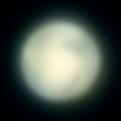 |
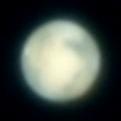 |
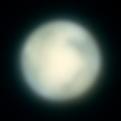 |
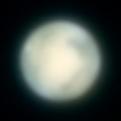 |
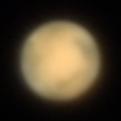 |
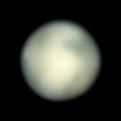 |
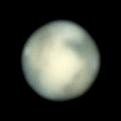 |
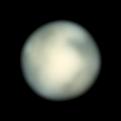 |
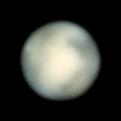 |
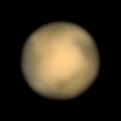 |
Philips SPC 900NC Webcam with 8″ f/6 Newtonian + 3X Barlow 3/8/12 Palo Alto, CA
These were taken one evening near the 2012 Mars opposition. This is my first experiment with the Philips webcam, using the f/9 Dobsonian reflector I've had since high school, and the 3X Barlow lens. The lack of tracking made it quite difficult to keep Mars in the field of view at this magnification. The images shown here were obtained by summing the "best" frames from each set, as determined from a limb sharpness estimation procedure. The first row shows the "raw" images obtained by summing, and the second row shows the same images with the contrast enhanced (at the expense of chopping off pixels with brightness below a minimum threshold). For these images, the focus was adjusted in between sets, and also the exposure time was shortened for the last set. The color doesn't look quite right for any of the images - visually, Mars has an orange appearance.
Mars
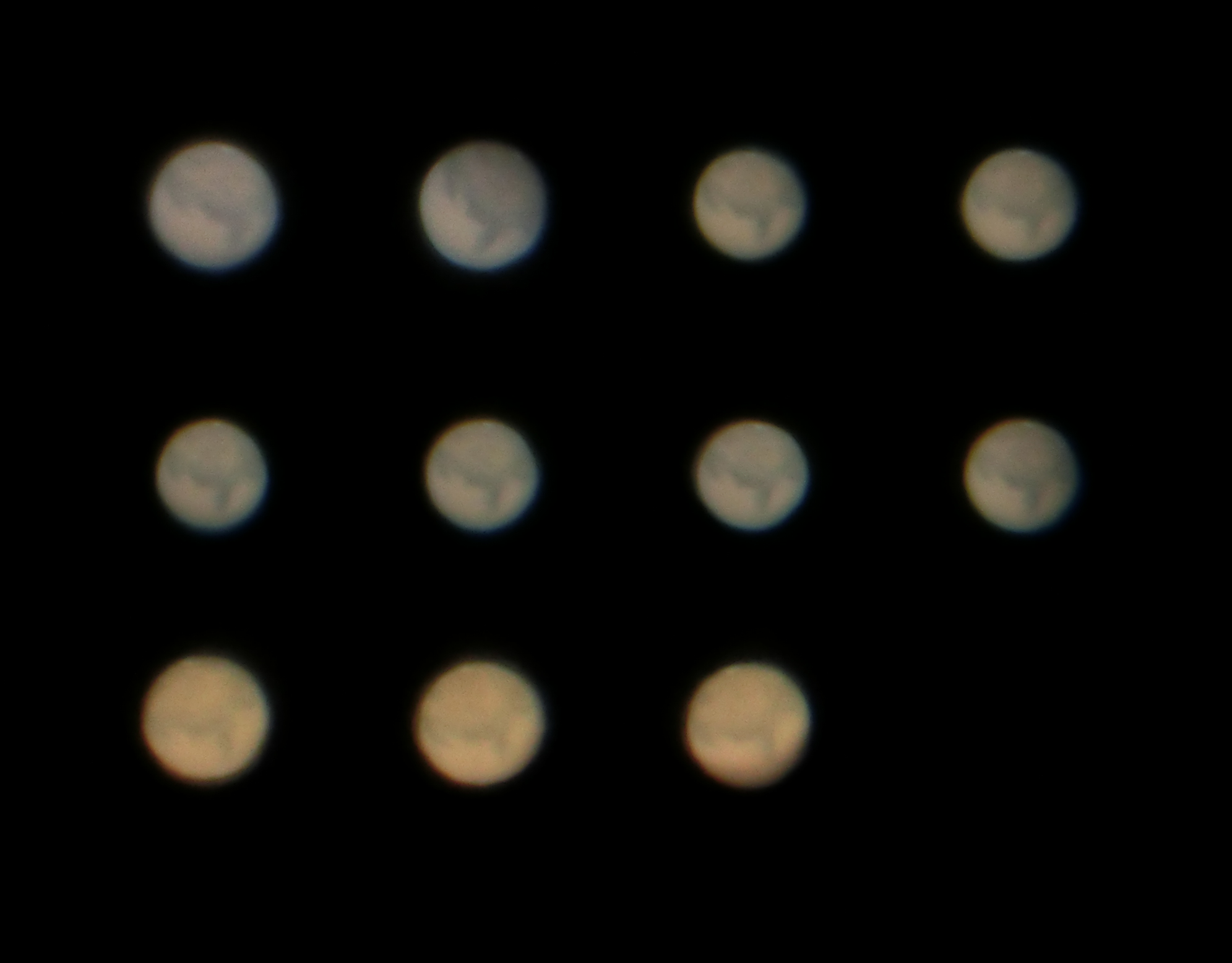
Casio camera through eyepiece, 10/17/20 Palo Alto, CA
These are the best exposures I got aiming my camera through the eyepiece near the 2020 Mars opposition.
Mars
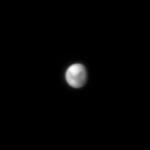 |
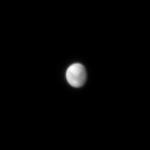 |
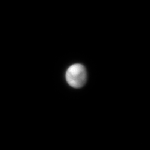 |
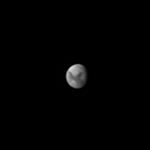 |
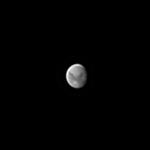 |
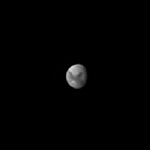 |
| 10ms | 50ms, green | animated |
Alvium 1800 U-319m with C14, 9/21/22 Lake San Antonio, CA
Mars will reach opposition in December, but it is already getting bright, high in the sky, and showing visible detail. I took two sequences of 2000 frames with the Allied Vision camera, one without a filter and one with a green filter. The images without a filter have better contrast. The top row shows the best raw frame from each set (using an automated sharpness metric) and the bottom row shows the results of combining the best 50 frames with Registax and applying a sharpening filter.
Mars
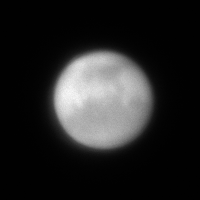 |
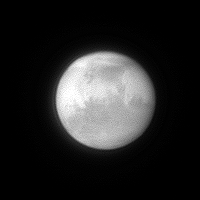 |
| sharpest frames | stacked, sharpened |
Alvium 1800 U-319m with C14, 11/26/22 Palo Alto, CA
These animations of Mars are based on another sequence of images taken close to the 2022 opposition. The left image shows the sharpest raw frame from each set, and the right image shows the results of combining the best 100 frames with Registax and applying a sharpening filter.
Ceres
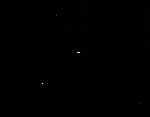 |
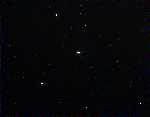 |
 |
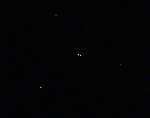 |
| Imax=2000 | Imax=200 | Imax=20000 | Imax=2000 |
Starshoot DSCI with 8″ f/6 Newtonian, 549 exposures, 1s each 6/5/10 Palo Alto, CA
Ceres is the largest object of the Asteroid Belt between Mars and Jupiter. Diameter = 957 km (RASC Observer's Handbook), or 0.075 Earth diameters. In the two images on the left, the 1s exposures were taken over a period of 23 minutes and combined such that the background stars are fixed. Ceres (the bright object in the middle) appears as a streak due to the relative motion between Earch and Ceres. This was taken close to opposition (Ceres is in the opposite direction as the Sun) so Earth (which orbits the Sun faster) is overtaking Ceres. The third image used 0.2 sec exposures, combined so that Ceres is fixed. It appears only as a point since the imaging resolution here is not adequate to resolve its disk, estimated to be 0.75 arcseconds. The last image was obtained be combining only the first and last images of the 1s exposures, taken 23 minutes apart. With the background stars fixed, Ceres appears as two spots. By measuring the distance between these spots, assuming circular orbits and assuming we are at opposition, I was able to estimate the radius of Ceres's orbit to be 2.86 a.u. (2.86 times the Earth-Sun distance) which is quite close to the actual mean distance of 2.77 a.u. given in the RASC Observer's Handbook. Explanation of this estimate.
Jupiter
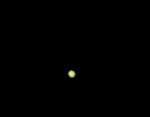 |
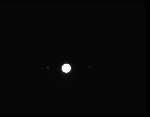 |
| 0.02s+moon | 0.1s |
Starshoot DSCI with 8″ f/6 Newtonian, Short exposures 5/31/08 Sunnyvale, CA
These were my first attempts at Jupiter. It saturates even for the shortest possible exposures, so I used a "moon" filter for the 0.02s exposure which unfortunately also messes up the color (it adds a greenish tint). The longer exposure (without the "moon" filter shows the 4 moons of Jupiter.
Jupiter, 3X
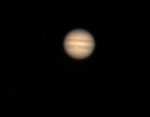 |
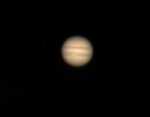 |
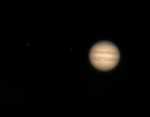 |
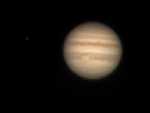 |
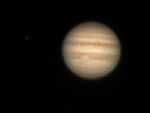 |
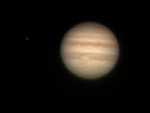 |
| try 1 | try 2 | try 3 |
Starshoot DSCI with 8″ f/6 Newtonian + 3X Barlow, 60 exposures, 0.02s each 7/13/08 Sunnyvale, CA
These are the first Jupiter attempts using a 3X Barlow lens. In each set, 60 separate images were combined using a somewhat different method from the one used on all of the deep sky images above. Although the resolution is not great, the red spot is obviously there. The top row shows the original results, while the bottom row shows an attempted deconvolution using a Richardson-Lucy routine implemented in Matlab.
Jupiter, 3X
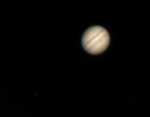 |
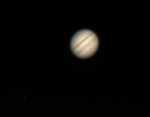 |
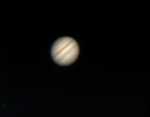 |
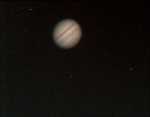 |
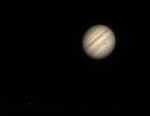 |
| #1: 60x0.02s | #2: 60x0.02s | #3: 60x0.05s | #5: 10x1s | #1, deconvolved |
Starshoot DSCI with 8″ f/6 Newtonian + 3X Barlow, 8/23/08 Sunnyvale, CA
Another attempt on Jupiter. Seeing was OK, but clouds moved in after 20 minutes. In image #5, there were already fairly thick clouds covering Jupiter. The colorful little artifacts are not parachuting aliens, but rather are due to hot pixels. Normally these would be removed, but no dark subtraction or bad pixel removal was done for this sequence.
Jupiter (with Io shadow)
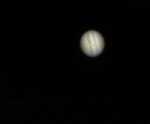 |
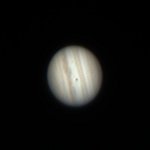 |
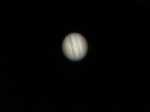 |
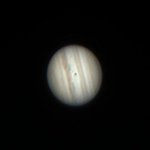 |
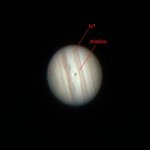 |
| Imax=450000 | deconvolved | Imax=450000 | deconvolved | labeled |
Starshoot DSCI with 8″ f/6 Newtonian + 3X Barlow, 31 exposures, 0.02s each 9/17/09 Lake San Antonio, CA
When we turned the telescope to Jupiter we were fortunate to see Io's shadow crossing the planet. Io itself could also barely be made out. The seeing was good (compared with what we are used to around our apartment), and for much of the time we could see much more detail in Jupiter's clouds than appears in these images. The shadow of Io was also more distinct, quite black in the center. The degradation in the image is probably caused partly by the Barlow lens and partly by readout issues with the camera. Over the course of ~1 hour, we watched as first Io emerged from the left side of Jupiter, and then the shadow completed its transit.
Jupiter
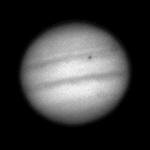 |
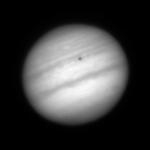 |
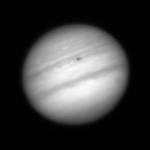 |
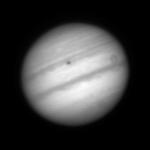 |
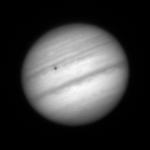 |
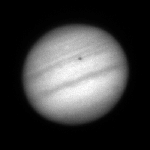 |
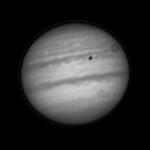 |
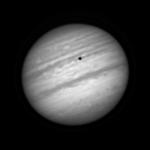 |
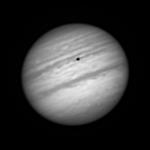 |
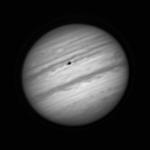 |
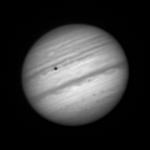 |
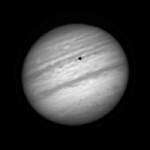 |
| 10ms, green | 10ms | 20ms | 50ms, green | 50ms, green, gain 10 | animated |
Alvium 1800 U-319m with C14, 9/21/22 Lake San Antonio, CA
When we started observing Jupiter, we saw that a moon was just starting to transit along with its shadow. At first, the moon was easy to see against the darker limb of Jupiter, but as it moved towards the center of Jupiter, it became difficult to see. From online data, I think the moon was Io. I took some frames with the Allied Vision camera, with and without a green color filter and with different exposure settings. The images with the green filter may show a bit more contrast. Each set had 2000 frames. The top row shows the best frame selected from each set, using an automatic sharpness metric based on Gaussian filters. The bottom row shows the results of stacking the best frames using Registax, and then applying a sharpening filter. The first image on the left used the best 200 frames (I needed more frames because of the low signal-noise ratio) while the other images used the best 50 frames.
Jupiter and Saturn
|
|
|
Here are a couple of images from the Jupiter-Saturn conjunction at the end of 2020, showing how close together the planets appeared in the eyepiece on 12/21 (left) and how low in the sky they were after sunset on 12/22 (right).
Saturn
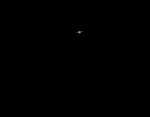 |
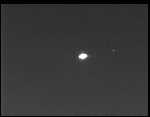 |
| 1 x 0.02s | 60 x 0.02s |
Starshoot DSCI with 8″ f/6 Newtonian, 0.02s exposures 6/1/08 Sunnyvale, CA
These are some early attempts at Saturn, before I had the Barlow lens.
Saturn
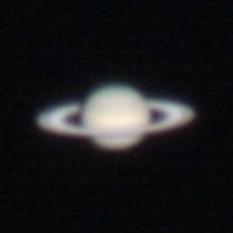 |
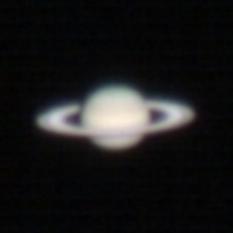 |
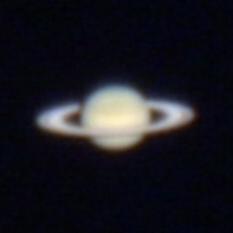 |
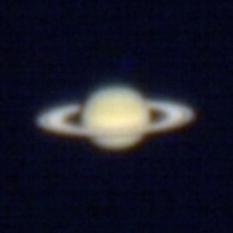 |
Philips SPC 900NC Webcam with 8″ f/6 Newtonian + 3X Barlow 6/14/12 Monte Bello, CA
Here are some attempts at Saturn using the webcam and the 3X Antares barlow. A complicated procedure was used to find the best frames to combine from the video (first choose the frames with the sharpest ring edges, combine these into a first combined image, then go back and choose the frames with the best 1st derivative overlap with the combined image). Nevertheless, it doesn't seem that the features in these combined frames are as crisp as what could be seen visually. Some adjustment to the color balance was also necessary (I rescaled R,G,B to force the rings to be white).
Uranus
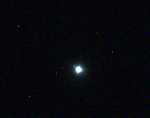 |
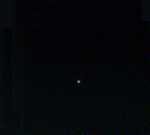 |
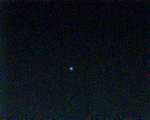 |
| Imax=75 | Imax=8000, 3X | Imax=15000, 3X |
Starshoot DSCI with 8″ f/6 Newtonian, 10 exposures, 10s each 7/10/10 Adin, CA
The first image is with a relatively long exposure in an attempt to see the moons. Uranus has four moons of magnitude ~14: Ariel, Umbriel, Titania and Oberon. Their maximum angular separations from Uranus are 13.8, 19.2, 31.5, and 42.1 arc seconds, respectively (RASC Observer's Handbook). Only the speck closest to the planet has an angular separation small enough that it could be a moon. Near this speck is also a suspicious bump that may just be a diffraction artifact. The other two images are made from very short exposures and using a 3X Barlow lens. There was a lot of wind and turbulence, and only the best frames were kept.
Neptune
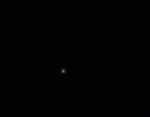 |
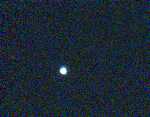 |
| Imax=1000 | Imax=50 |
Starshoot DSCI with 8″ f/6 Newtonian, 283 exposures, 1s each 10/8/10 Lake San Antonio, CA
Neptune's apparent diameter is approximately 2.3 arc seconds, which is on the edge of what can be resolved here. The faint object at 9:30 could be Triton, but I'm not sure.
Pluto
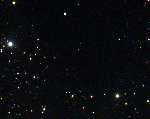 |
| Imax=50 |
Starshoot DSCI with 8″ f/6 Newtonian, 13 frames, 10 minute intervals 7/4/10 San Jose, CA
Click the image above to view an animated GIF movie of Pluto. This animation shows Pluto (slightly above center) appearing to move relative to the background stars in the dark nebula B92. There are 13 frames with approximately 10-minute intervals between them. Each frame was generated from many 10s exposures, combined in the ususal way. There is also some field rotation, suggesting bad polar alignment of the equatorial mount. Since Pluto was close to opposition (Pluto is in the opposite direction as the Sun), the apparent motion is mainly a parallax effect due to Earth's motion (Pluto's orbital period is ~248 years, but its actual velocity relative to the Sun is ~1/6 that of Earth's). By measuring the apparent motion of Pluto relative to the background stars, I estimated the radius of Pluto's orbit to be 34 astronomical units (34 times the Earth-Sun distance). Pluto's actual orbit is rather elliptical, but its distance from the Sun in 2010 is approximately 31.85 a.u. (RASC Observer's Handbook). Explanation of this estimate.
Comet Hyakutake
|
|
|
|
|
| 30s | 120s | 60s, with Little Dipper | through telescope |
|
|
|
|
|
| 150s | 300s | 20s, from house | 640s, from house |
Pentax 35mm camera, March 1996, Arizona
I was fortunate to be at home in Arizona on spring break when comet Hyakutake passed by. The top four photos were taken with fast color film (Kodak Royal Gold 1000), and the bottom four with slower (ASA 200) film. Because the comet was near the north celestial pole, it was possible to take fairly long exposures without tracking and still get decent results. The first six images were taken at a semi-dark sky location somewhere south of Phoenix, I believe, while the last two were taken from our house. The image at upper right (aiming the camera through the telescope) is blurred because there was no tracking. Tracking would have been difficult, since the comet was moving quickly relative to the background stars; in the long exposure at lower right it is clearly moving in a different direction from the star trails.
Comet Hale-Bopp
|
|
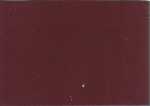 |
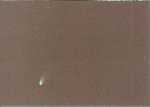 |
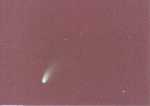 |
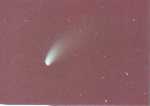 |
| Scottsdale | East End | East End | East End | East End |
Pentax 35mm camera, April 1997, Arizona
The first picture was taken at our house in Scottsdale. The others were taken near East End in the McDowell Mountains. Unfortunately, the prints from this set had color problems, for unknown reasons. I adjusted the color somewhat in the scanned images to make the sky less red.
Comet Holmes
|
|
|
|
|
| 5s, direct (zoomed) | 1s, telescope | 2s, telescope | 4s, telescope |
Canon Powershot G3, 11/4/07, Sunnyvale, CA
The picture on the left was taken by aiming the camera directly at the comet, while the others were taken by pointing the camera throught the telescope eyepiece.
Comet C/2018 W2 (Africano)
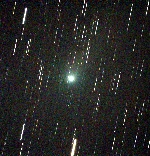 |
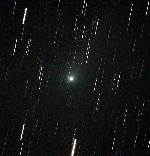 |
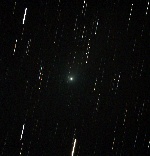 |
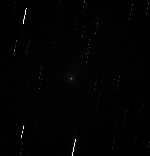 |
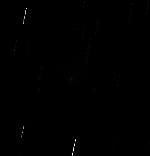 |
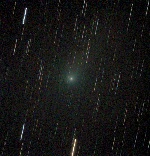 |
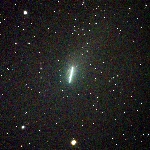 |
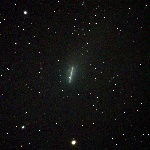 |
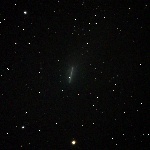 |
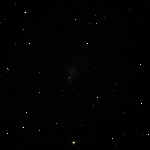 |
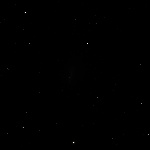 |
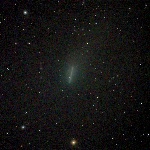 |
| Imax=1 | Imax=2 | Imax=4 | Imax=16 | Imax=64 | Nonlinear |
SBIG ST-4K with 8″ f/6 Newtonian, 1200s total exposure 9/26/19 Lake San Antonio, CA
This comet was near its closest approach of approximately 0.5 A.U. and moving rapidly through the constellation Pegasus on the night of Sept. 25-26, 2019. Initially I tried a 5-minute exposure with the normal autoguiding procedure, using a background star, but the comet moved too much during the exposure. Instead, I took a sequence of 40 30-second unguided exposures. These exposures could then be combined through image registration, using either the comet (top row) or the background stars (bottom row). The stars do not always appear as symmetric points because of tracking errors during the 30s exposures, a drawback of skipping the autoguiding. The comet appears to have a bright nucleus with a small, circular cloud surrounding it, but not much of a tail.
Comet NEOWISE
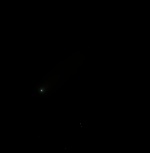 |
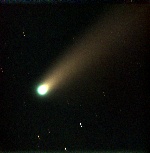 |
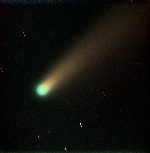 |
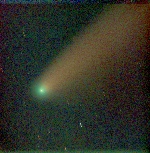 |
| Imax=1500 | Imax=30 | Nonlinear | Nonlinear |
SBIG ST-4K with 8″ f/6 Newtonian, 200s total exposure 7/19/20 Palo Alto, CA
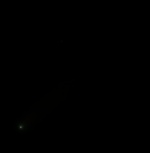 |
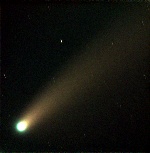 |
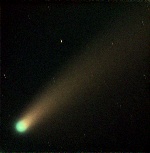 |
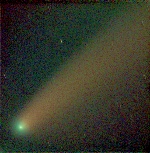 |
| Imax=1500 | Imax=30 | Nonlinear | Nonlinear |
SBIG ST-4K, 200s total exposure 7/19/20 Palo Alto, CA
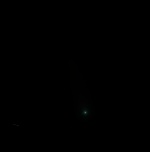 |
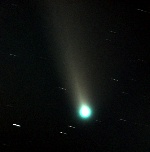 |
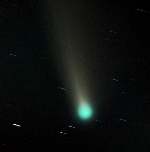 |
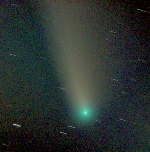 |
| Imax=1500 | Imax=30 | Nonlinear | Nonlinear |
SBIG ST-4K, 320s total exposure 7/22/20 Palo Alto, CA
When comet NEOWISE became visible from our yard, it was not extremely bright, requiring binoculars to see clearly. The images above were made by combining many 10-second exposures. Since the comet was moving rapidly in the sky, the background stars appear as streaks.
Comet Tsuchinshan-ATLAS
 |
 |
 |
| digital zoom 2.81 | digital zoom 2.81 | digital zoom 7.01 |
 |
 |
 |
| 15s at 7mm focal length | 15s at 29mm focal length | 8s at 29mm focal length |
 |
 |
 |
 |
 |
| Imax=1600 | Imax=100 | Imax=16 | Imax=6 | Nonlinear |
 |
 |
 |
 |
 |
| Imax=1600 | Imax=100 | Imax=16 | Imax=6 | Nonlinear |
Comet Tsuchinshan-ATLAS became visible in the evening about a week after Calstar. We only observed it from the city, but managed to capture some images. Top row: images taken by Kathy with her phone on the first night we saw the comet from a nearby parking structure. At that time the comet was visible without binoculars despite many bright lights nearby, and we saw it much better with binoculars, but there was only a ~30 minute window after sunset to get a good view before it got too low in the sky. Second row: images taken from our patio six days later, when the comet was in a better viewing position but also noticeably dimmer. Third and fourth rows: close-up images taken through the telescope 3 days later with different exposure settings and scalings used for display. These images show the comet's star-like nucleus, the round coma surrounding it, and the start of the tail. A dark streak can also be seen, perhaps a shadow or part of the dust tail? The background stars appear as streaks because of the comet's motion during the exposure sequences. By this time, the comet was difficult to find in our bright sky even with binoculars.